Aidan Browne and his team are taking the fight against cyber attacks to the floors of America’s manufacturing industries
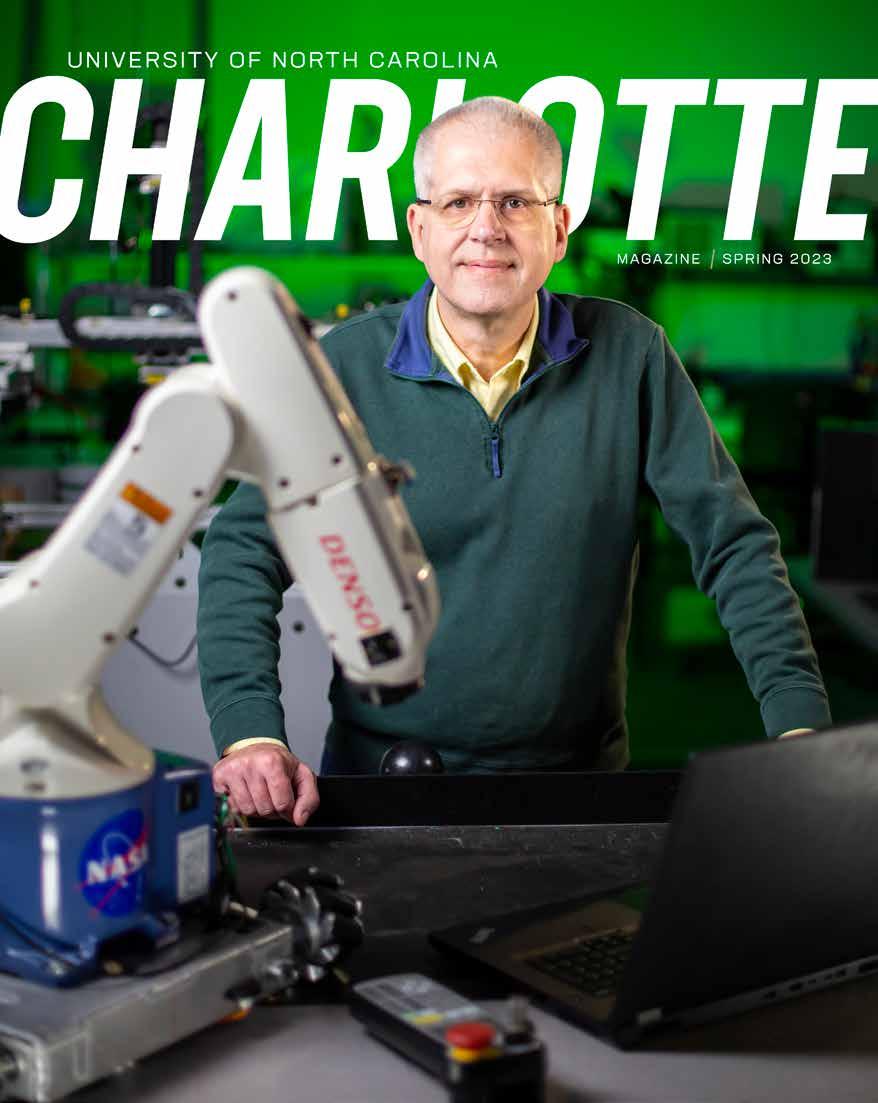
Demond T. Martin ’97, a savvy investor and committed philanthropist, was presented an honorary Doctor of Public Service during one of the four Charlotte Spring Commencement ceremonies. More than 5,300 degrees and graduate certificates were awarded during exercises May 12-13.

Martin, in addressing the audience, shared his life’s journey of overcoming obstacles, such as poverty and the fear of living in unsafe environments. “But, where you start is not where you finish.”
Motivated to seek, build and improve community, Martin believes it is his duty to help as many people as he can.
Scan the QR code to learn more about Martin and his philosophy of philanthropy to his community and the University.
 PHOTO BY KAT LAWRENCE
PHOTO BY KAT LAWRENCE
Steps Toward Achieving Big Goals

Looking back over the 2022-23 academic year, I’m so happy with all UNC Charlotte continues to accomplish. Students, alumni, faculty and staff are rising to meet our vision to be a globally recognized top-tier research university and to make an even greater impact on our region through engaged scholarship, innovative programs and connected community collaboration.
Our spring achievements indicate we’re on the right track. Among the highlights:
• U.S. News & World Report cited 11 graduate programs from across our academic offerings in its 2023-24 Best Graduate Schools rankings, giving Charlotte 19 graduate programs or specialties in the top 100 in the country.
• The Cato College of Education received one of the largest gifts in University history. The North Carolina-based Mebane Foundation awarded the University a five-year grant and an endowment of more than $20 million. This transformational investment, earned through a statewide competitive process, will further strengthen the Cato College as a national leader in teacher literacy innovation and greatly expand our early literacy teacher development, community engagement and research.
• The William States Lee College of Engineering is providing the critical momentum to support the state’s top area of economic development: renewable energy and next-generation battery research and manufacturing. One example of this innovation is the North Carolina Battery Complexity, Autonomous Vehicle and Electrification Research Center — or BATT CAVE — the state’s only university-led center for battery research. As North Carolina becomes a vital hub for electric vehicle and battery manufacturing, this center will shape research and development advancement and industry expansion, and fuel the workforce with career-ready graduates.
• The Southern Association of Colleges and Schools Commission on Colleges, our accrediting body, concluded its reaffirmation of accreditation for UNC Charlotte with zero recommendations and four positive notations, the best possible outcome. This outstanding accomplishment speaks to Charlotte’s deep commitment to both academic excellence and the most rewarding experience for our students.
The stories in this issue of UNC Charlotte Magazine reflect the remarkable research and teaching strength of our faculty, the desire of our students to excel and their persistence in doing so, and the ways our Niner alumni are making a difference in their communities and across the globe. Their Niner spirit is what makes UNC Charlotte stand apart.
After catching our breath this summer, we will be ready to welcome the Class of 2027, a diverse group that affirms the eagerness of more and more students to take advantage of the life-changing education and opportunities available only at Charlotte. We are grateful for your ongoing support of North Carolina’s urban research institution — and our entire campus community.
Go Niners!
Sharon L. Gaber Chancellor
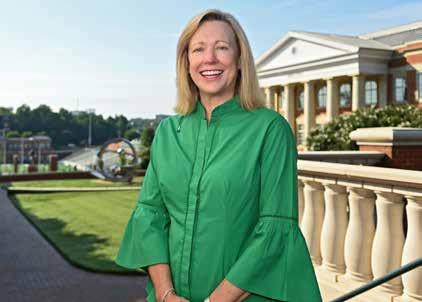
1 FROM THE CHANCELLOR
Transforming the lives of students through educational opportunity and excellence

4 ACCESS
Chad Stachowicz ’21 ’22 M.S. grew up admiring team owners, not players. The result, the global startup Cloverhound.
8
GOING FOR GOLD
Record-breaking sprinter for the 49ers track and field team Maya Singletary is upholding and extending her family’s tradition of community service.
14 60208
Andrew Brotherton ’22 is on a quest to save lives. Now a Ph.D. candidate, he is working on a new tool to better diagnose heart attacks.
18
ALL-IN-C
49ers women’s soccer player Brenna Murray is a force behind Niner Fire, a peer approach to student-athlete mental health.

34 OPPORTUNITY
Adversity did not deter data scientist Khem Khadka ’22 from persisting toward his goals — or making the most of every available opportunity.
Powering the future through inquiry, research and creative discovery

10 CREATE
Associate Professor Kim Jones envisions movement from memory by resurrecting the work of forgotten Korean dancer Choi Seung Hee, regarded as Korea’s first modern dancer.

22 INNOVATE
Engineering professor Aidan Browne and his colleagues are developing solutions designed to curb — or stop — the most real of threats faced today by manufacturers across industries — cyber attacks.
31 DISCOVER
Unearthing new knowledge about early 20th-century Black education motivates graduate student Camille Richardson, bioarchaelogist Sara Juengst and their colleagues to learn more about how Black students experienced school a century ago.
Driving progress for North Carolina and beyond
26 NINER TO NINER
Ryan Kennedy ’04 heads Atom Power, an innovative and fast-growing enterprise revolutionizing electrical vehicle charging technology. An accidental entrepreneur, he shares advice with other pioneering 49ers.
28 49ER FOCUS
UNC Charlotte and Charlotte Mecklenburg Schools collaborated to create the Aspiring High School Principals program, an innovative approach to recruiting, training and supporting prospective school leaders.

38 METRO
Marc Manack’s architecture students refine their hands-on skills while helping to solve real-world problems; this spring, they are tackling a possible solution for affordable housing.
2
PHOTO BY KAT LAWRENCE
Leading in equity and engagement
16 ENGAGED
Kwame Molden ’12 MBA is building a brand to watch as co-founder of Springbreak Watches, which is clocking nationwide success with his creations showing up in retailers nationwide.
20 CENTER SPREAD
Service and development of young men are core values for Charlotte 49ers head football coach Francis Xavier “Biff” Poggi.
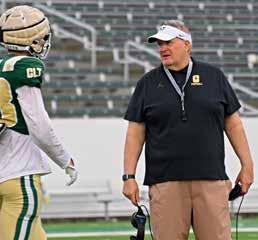
36 VOICES
Terri White, CEO and president of the Charlotte Museum of History, is a doctoral candidate in the Belk College of Business, researching diversity, equity and inclusion in the American distilled spirits industry.
MISSION
UNC Charlotte Magazine, the University’s principal print publication, aims to engage, inform and inspire its diverse readership about students, faculty, staff and alumni whose experiences represent the opportunities, creative and scholarly research, and diversity of Niner Nation, and its impact on the city of Charlotte and beyond. Storytelling is guided by the goals of UNC Charlotte’s strategic plan.
FEEDBACK
We want to hear from you. Email questions and comments to univcomm@uncc.edu
www.charlotte.edu
Vol. 29 • No. 1
Jennifer Ames Stuart, Ph.D.
Associate Vice Chancellor for University Communications
EDITOR
Phillip Brown
Assistant Director of Strategic Content
CONTRIBUTING WRITERS
Bryant Avery
Sonja Barisic
Phillip Brown
Monica Hughes
Christy Jackson
Lindsay Lennon
Jenny Matz
Susan Messina
Lynn Roberson
Laura Smailes
Michael Solender
Meg Whalen
CREATIVE DIRECTOR
Ryan Honeyman
Director of Creative Services
PHOTOGRAPHERS
Ryan Honeyman
Kat Lawrence
UNC Charlotte Magazine is published by The University of North Carolina at Charlotte 9201 University City Blvd. Charlotte, NC 28223-0001 ISSN10771913
EDITORIAL OFFICES Foundation Annex, UNC Charlotte 8730 University City Blvd. Charlotte, N.C., 28223 704-687-7214
Email: univcomm@uncc.edu.
Students from the College of Arts + Architecture have completed a mural that spans the center arcade connecting the Colvard North and South buildings.

The University of North Carolina at Charlotte is open to people of all races and is committed to equality of educational opportunity and does not discriminate against applicants, students or employees based on race, color, national origin, religion, sex, sexual orientation, age or disability.
27,500 copies of this publication were printed at $1.45 per piece for a total cost of $39,984.
3
PHOTO BY RYAN HONEYMAN
COVER PHOTO BY RYAN HONEYMAN
RUNNING WITH THE BIG DOGS
Chad Stachowicz ’21 ’22 M.S. takes Cloverhound — his startup communications venture — global
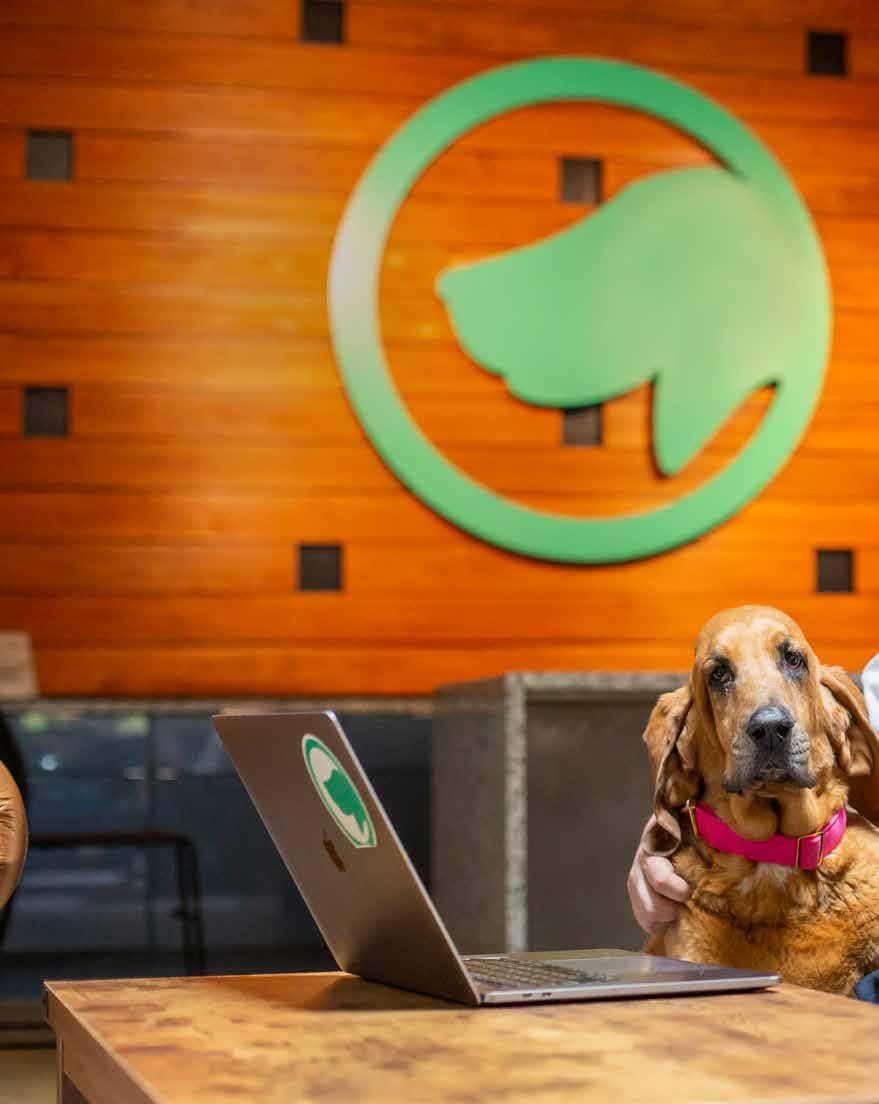 BY LAURA SMAILES
BY LAURA SMAILES
The 49er Foundry celebrated 10 years of student entrepreneurship recently as the Center for Entrepreneurship and Innovation hosted a reception honoring Stachowicz and several other UNC Charlotte alumni who have made an impact in the entrepreneurial community, not only in Charlotte but nationally. Read more about the celebration and what 49er Foundry alumni are doing today.

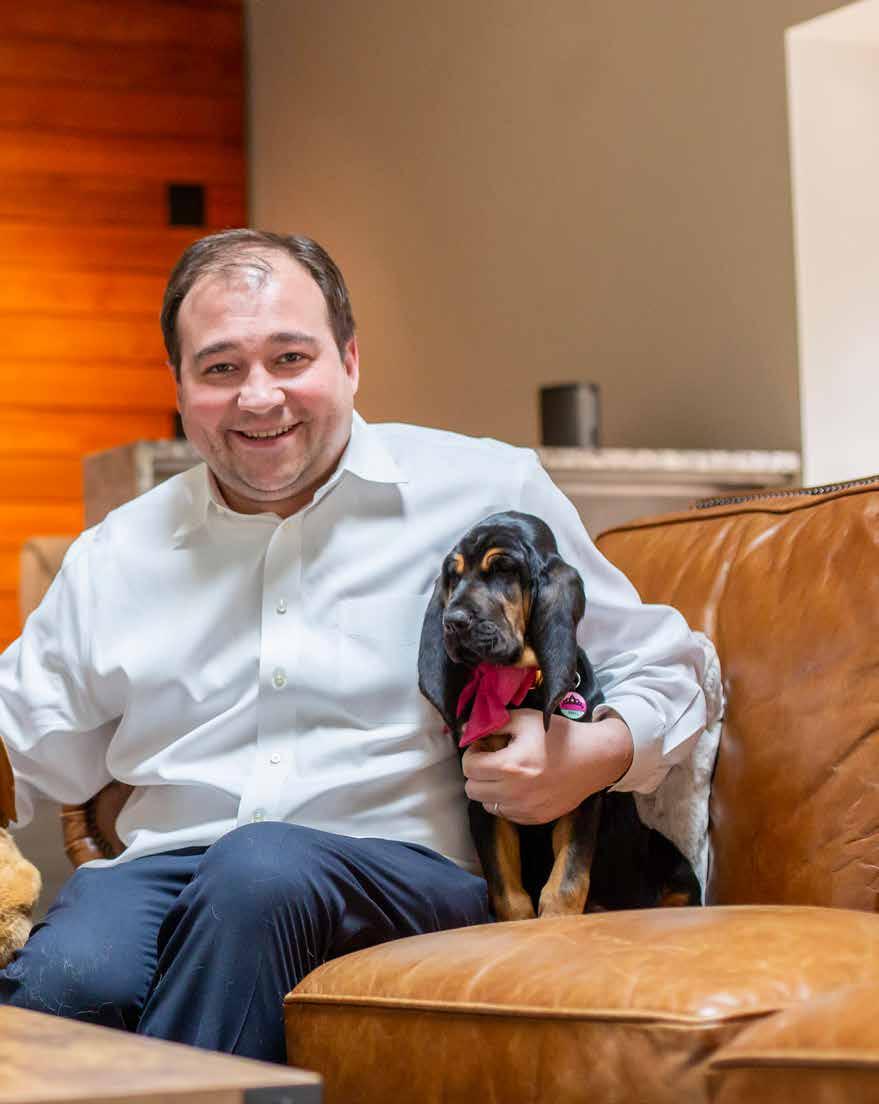 PHOTO BY RYAN HONEYMAN
PHOTO BY RYAN HONEYMAN
It’s not uncommon to hear of kids who dream of making it big in sports, dunking like Michael Jordan. Not Chad Stachowicz ’21 ’22 M.S. — his heroes weren’t the players but the owners.
“When I was 11 years old, my friends and I didn’t follow sports teams. We were obsessed with the owners of those teams: the Mark Cubans. That’s who I admired,” said Stachowicz.
Although Stachowicz doesn’t own an NBA team like M.J. does today, he has achieved entrepreneurial success by developing customized communication platforms for a number of Fortune 500 companies through Cloverhound, his Charlotte-based venture with an international footprint.
DEVELOPING SOLUTIONS
Stachowicz, even as a child, was driven to change the world. He found joy in seeking answers to questions others thought unimportant. Stachowicz struggled to identify his passion for problem solving, but he says he absolutely felt driven to prove himself. Unabashedly energetic, he feared neither judgment nor being the center of attention. The one place he says he felt focused was behind a computer.
When Stachowicz’s grandmother surprised him with his first computer, he was ecstatic.
It was then that his future began to take shape. In high school, he created an application so his mother could track her finances. While his computer teacher was impressed with the intuitive design of the app, Stachowicz relished in helping his mother. He had solved his first real problem with a computer.
FINDING CUSTOMERS
Stachowicz in 2011, as a UNC Charlotte undergraduate, launched his first startup. Minds Mesh was a plug-in to use with the campus learning management system. He recognized students were frustrated by being “forced” to use something they deemed unentertaining. He thought, “What if I made this social? [I could] change it to a platform where we could talk about an upcoming test or group project.”
As a sophomore, he joined 49er Foundry, UNC Charlotte’s student idea incubator, and with the assistance of the Center for Entrepreneurship and Innovation (formerly Ventureprise), Stachowicz landed some big customers: UNC Charlotte, Davidson College, Wake Forest University and Elon University. He received $50,000 in angel funding and after the first year had more than $50,000 in sales. He still has that initial check, a symbol of personal validation. It reminds him, “I created this.”
For a kid who felt he had something to prove, he was off to a good start.
MAKING A PIVOT
While working full time installing phone systems at Fortune 500 companies and gaining a lot of traction with Minds Mesh, Stachowicz decided to leave school.
A few years into balancing a full-time job and his “side gig,” he seized a rare opportunity. His employer parted ways with one of its biggest clients, and Stachowicz, at the urging of his wife,
WHAT’S IN A NAME?
Stachowicz never gets tired of people asking about the name of his startup. In fact, he says it was the name that helped him get noticed as he launched.
At the advice of a local Charlotte investor, Stachowicz was told to “find something you can easily spell and find on the internet. Make it simple.”

Along with his passion for innovation, entrepreneurship and problem solving, comes his love for Notre Dame and his dogs. Together, they gave him the name Cloverhound. The green dog logo has since become synonymous with Cloverhound, even though he initially forgot to put the name of the business on the logo.
Kathryn, jumped at the opportunity to leverage his entrepreneurial perspective. He asked the customer for a chance to design a custom communication system.
“I was either going to be a success or a failure. And failure is the first step to success,” said Stachowicz.
He excelled.
Being an expert in your market is essential to leading your own company, he added. While he had initial success with Minds Mesh, the app’s sustainability wasn’t certain. Stachowicz reimbursed his Minds Mesh investors to focus on installing communication platforms for corporate customers, and Cloverhound was launched.
Solving everyday problems was Stachowicz’s passion and this focus on large-scale corporate communications systems would enable him to make the impact he was seeking.
DEVELOPING A TEAM FOR SUCCESS
As Stachowicz continues to expand his team, he says he looks to hire two types of people, “those who know nothing and those who know everything.” So far, his formula is a success.
UNC Charlotte graduate Angelica Srivoraphan ’10 was one of his first hires. Srivoraphan, who completed a bachelor’s degree in business administration from the Belk College of Business, had ideas and sought an environment that would foster her passion for innovation.
Stachowicz, who was focused on the technology aspect of Clo-
6
verhound, needed a project leader to move the company forward, and Srivoraphan’s breadth of knowledge has been a winner for eight years. She exudes energy and enthusiasm, excited to come to work each day, and she takes great pride in what Cloverhoud achieves for its customers.
Srivoraphan describes Stachowicz’s management style as inspiring and open. “Being able to create new products and systems is exciting and important. He gives us room to grow. He will give you a task and expect you to complete it, and he also has your back. He encourages us to ask for help. We collaborate. We will always figure it out.”
Stachowicz is known as an appreciative leader. More than half of Cloverhound employees participate in the stock incentive program. They are invested in the company. Just as he is.
When Cloverhound occasionally loses personnel, they usually leave for Silicon Valley. “I am proud of the people we are developing,” Stachowicz says.
GIVING BACK
As Cloverhound grows, Stachowicz continues to give back — to his employees, his clients and UNC Charlotte, where his first official profitable startup began. In 2019, he was invited to get involved with campus entrepreneurship through the University’s Center for Entrepreneurship and Innovation.
Through campus interactions, he realized the value of not only
When asked about what advice he most gives, Stachowicz loves to let people know that most businesses are not glamorous. Yet they all have to meet a need and solve problems.
Something everyone notices about the energetic founder in the first few minutes of meeting him is that he honestly cares about solving problems and giving clients fullservice experiences. In fact, he prioritizes people over raw learning.
“I am always questioning things. You never know, there could be a different problem out there that you have no idea exists.” In talking with Cloverhound project leader Angelica Srivoraphan '10 on the topic, she reinforces this saying, “One thing about Chad, he cares about the product and being able to help our clients.”
completing his degree but extending his studies. Returning to mentor future entrepreneurs led Stachowicz to complete a bachelors’ degree in computer science, and, in 2022, earn a Master of Science in Bioinformatics.
“One of the reasons I really enjoyed my time at UNC Charlotte was that the faculty engaged in meaningful conversations. If you brought up a tough question, they embraced it. There was not a wrong way or a right way, just a way,” he explained.
Stachowicz still mentors in the 49er Foundry, and he serves as a judge for the Center for Entrepreneurship and Innovation pitch competitions, hires students after graduation and supports intern programs. In fact, 25% of the workforce in Cloverhound’s Charlotte office are 49ers alumni, as are the majority of recent interns.
BUILDING A LEGACY
With superior client service a priority, Stachowicz ensures his clients are able to maintain and improve the quality of their communications with customers.
What matters, he says, is that relationships are developed and clients return. He has built his reputation on this and his success tells the story. Cloverhound is now an international company, with 70 employees and offices in Charlotte, Colorado and Costa Rica with $7.5 million in revenue in 2022.
Laura Smailes is assistant director for the Center for Entrepreneurship and Innovation.

7
BY BRYANT
Maya Singletary whizzes around the track, covering 400 meters in under a minute. She’s capitalized on her speed and athleticism to achieve outstanding results as a member of the Charlotte 49ers track and field team.
A five-time 400 meter and six-time 4x400 relay conference champion in both indoor and outdoor competition, Singletary owns the school record in the individual 400, which she broke as she won her fourth 400 meter title at the 2022 Conference USA Championships. In January, Singletary broke a nine-year indoor school record in the 600 meter, followed the next month by a new indoor school record for the 400.
At the 2023 C-USA Indoor Championships, Singletary captured her fifth 400 meter conference title and anchored the 4x400m relay, which shattered the conference meet record and set a new school record.
Singletary was drawn to Charlotte because of the opportunity to compete athletically at the Division I college level as well as to pursue her interests in epidemiology, the study of how the spread of diseases impact community. She completed a bachelor’s degree in communication studies in December 2021, and she is working on a second degree in health systems management.
“I want to provide people in underserved communities with access to care they otherwise wouldn’t be able to get,” said Singletary. “My goals are to educate the community, prevent the spread of diseases and create a healthier environment for future generations.”
A LEGACY OF SERVICE
The Raeford, North Carolina, native was introduced to community service at an early age by her grandmother.
“She was heavily involved in our town. Her house was the meeting place for people working with community organizations and for Bible study,” Singletary said. “Even though she died before
I was born, her devotion to service is ingrained in our family’s identity. To honor her is why I volunteer my time as much as I do.”
At Charlotte, Singletary volunteers with the Jamil Niner Student Pantry and the University Soup Kitchen. She’s also very involved with the Charlotte 49ers United in Gold initiative, established in 2020. Its goal is to educate student-athletes, coaches and staff about social inequalities that exist in society and how to be a conduit for change within communities. University volunteers extend United in Gold into the greater Charlotte-Mecklenburg region. After graduation, participants take lessons learned to their next communities.
“Through United in Gold, we have conducted athletics town hall meetings with local law enforcement, promoted voter education through voter registration drives and advocated via public service announcement videos. We also engaged with students at Niner Elementary on their first day of classes,” Singletary stated. “We strive to create a better and more inclusive community for all, and we hope this initiative will result in real change.”
Prior to United in Gold, Singletary joined the National Coalition of 100 Black Women, which advocates for Black women and girls to promote leadership development to foster a world where socioeconomic inequalities do not exist.
Singletary takes pride in her athletic accomplishments with the Charlotte 49ers track and field team.
“But that doesn’t define who I am as a person,” she said. “When my Charlotte career is concluded, I hope I will be remembered for volunteer work in the community and the changes I strived to create. All student-athletes should be involved in some way. It makes you a more well-rounded individual, and you have the opportunity to really change people’s lives for the better.”
8
Bryant Avery is a media relations assistant for the Charlotte 49ers.
A champion on the track, Maya Singletary strives to define herself through commitment to community service
AVERY
“I hope I will be remembered for the volunteer work in the community and the changes I strived to create.”
Maya Singletary
 PHOTO BY RYAN HONEYMAN
PHOTO BY RYAN HONEYMAN
(MEMORY BECOMES MOVEMENT)
BY MEG WHALEN PHOTOS BY KAT LAWRENCE
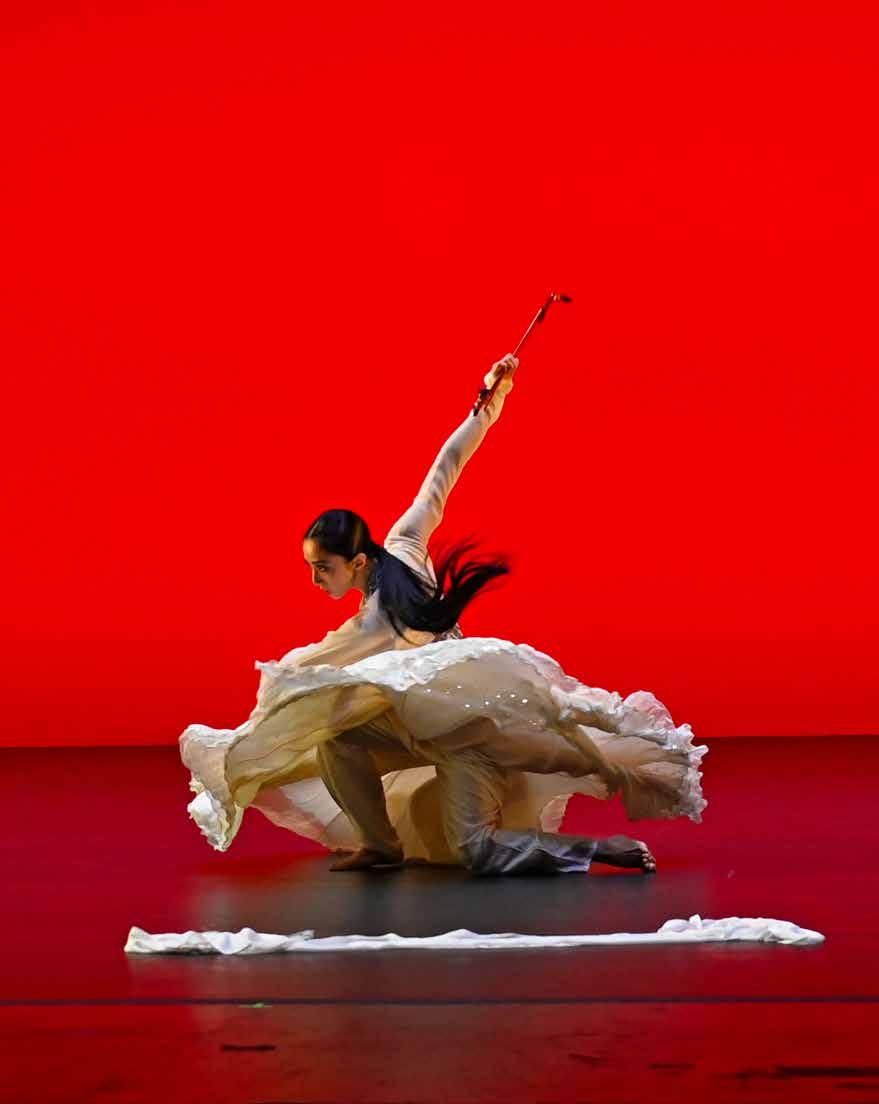
Associate Professor Kim Jones resurrects forgotten Korean dancer Choi Seung Hee

When Choi Seung Hee was purged from 1960s North Korea, her legacy, like her life, could have been snuffed out. Widely regarded as Korea’s first modern dancer, Choi had developed an international reputation in the 1930s, touring Europe and the United States. But the turmoil of the next two decades — World War II, the Korean War and the triumph of Communism in China and North Korea — charted a different path for the cosmopolitan choreographer and dancer.
Associate Professor of Dance Kim Jones had never heard of Choi Seung Hee until about 15 years ago, when a friend showed her a short video about Choi. Being both Korean (on her mother’s side) and a modern dancer (she was a Martha Graham Dance Company member), Jones was intrigued.
“Then I didn’t think about her again for 10 years or so.”
In the ensuing decade, Jones developed a reputation as a researcher and recreator of historical dances. In 2013, she brought to life a lost solo that modern dance pioneer Martha Graham had choreographed in 1935. Pieced together through interviews with former Graham dancers and archival study of photographs, newspaper articles and other materials, the reimagined “Imperial
Gesture” garnered attention from the New York Times and, after performances in Charlotte and New York City, was accepted into the Graham Company’s repertory.
Just three years later, Jones was asked to rescue another work from obscurity: “Tracer,” a 1962 work by the famed modern dance choreographer Paul Taylor. That work, also covered in the New York Times, is now performed by the Paul Taylor Dance Company.
It was while she was wrapping up her research on “Tracer” that Jones recalled the film of Choi Seung Hee.
“I was thinking about my own culture and thought, let me investigate her more,” she said.
Applying to the University’s Charlotte Research Scholars program, she received funding for an undergraduate research assistant in the summer of 2016 and tasked her with finding all she could about Choi — even sending the student to New York City to scour the dance archives in the New York Public Library. That same summer, Jones traveled to Korea and was able to interview and learn from an elderly woman who had danced with Choi, adding to the growing body of research.
The story that emerged was one of both triumph and tragedy.
11
Scan to read more about Dance for Freedom: Reimagining the Dances of Choi Seung Hee

(DANCE FOR FREEDOM)
FAMOUS THEN FORGOTTEN
Choi Seung Hee was born in Japanese Imperial Korea in 1911 and, as required by the colonial government, adopted a Japanese version of her name, Sai Shōki. When she was 15, she saw the Japanese modern dancer Ishii Baku perform in Seoul and was inspired to become a dancer. After convincing her parents to allow it, she traveled to Tokyo and spent three years studying with Baku before returning to Korea, marrying and beginning her career.
Choi’s brother and husband were both sympathetic to socialist politics, and Choi — like European and American early modern dancers such as Mary Wigman and Martha Graham — was attracted by many of the ideals of socialism, particularly the emphasis on feminism and the dignity of the working class. With works like “A Free Person’s Dance” (1931), Choi began to create a Korean sinmuyong, or “new dance,” that challenged Japanese Imperialism and traditional notions of femininity.
“There’s a writing where she says, ‘I dance for freedom,’” Jones said. “And I said, oh my gosh — freedom of her country, freedom as a woman, freedom as a Korean.”
Choi’s talent was prodigious, but political and cultural pressures were great. Turning away from socialist realism, she began to add more traditional Korean dance elements to her choreography and by the late 1930s was touring across the globe. When World War II broke out, the Japanese government sent her to entertain Japanese troops, which, once the war ended and Korea was liberated, prompted criticism from Korean nationalists.
In 1946, Choi’s husband, an active supporter of the Workers’ Party of Korea, went to North Korea, and Choi soon followed.
She founded a school, toured China, the Soviet Union and other Eastern Bloc countries, and began again to create dances with socialist realist themes. But eventually, internal strife within the regime led to a series of purges. Choi’s husband was arrested in 1959 and killed; Choi disappeared in 1967. In 2003, North Korea issued an official statement that she had died in 1969.
Ending up on the wrong side of a geographic and ideological border, Choi became more sullied than celebrated in South Korea and knowledge of her faded.
“It’s such a sad story — a story of war, of assimilation, of erasure,” said Jones.
RIGHTING THE HISTORY
In studios and classrooms in the United States, the known history and techniques of modern dance have been almost exclusively American and European. Research like Jones’ is opening up that tunnel vision.
“What we’re beginning to uncover is that there really were dance modernisms globally,” said Susan Manning, a professor at Northwestern University in Illinois and the author of the forthcoming “Critical Histories of Modern Dance.” “How does this history happen, and we not learn it?”
While Manning and other scholars are writing new histories of global modern dance that explore contributions like Choi’s, Jones is bringing that history to the stage in movement that is rooted in the research and resonates with her own dance training, her personal story and the connection she feels to Choi.
“What Kim is doing is very urgent for this moment,” said Manning. “She’s not arguing that she’s actually recreating this

12
Musician Vong Pak and dancer So Young An
dance. It’s lost. But how do we reimagine, reperform, reenact, rethink, recover? Kim’s work is making a huge difference in terms of how we understand modern dance.”
자유 DANCE FOR FREEDOM
In late 2019, Jones received a Faculty Research Grant to travel to Korea to meet again with Choi’s former dance student, Kim Yeong-Sun, a North Korean refugee in her late 80s. But the pandemic prevented the spring 2020 trip. Fortunately, So Young An, a current member of the Martha Graham Dance Company, was in Korea at the time. Jones was able to connect her to Yeong-Sun, and with the help of Zoom and production manager Hae Jin Han, she could join the two dancers as An learned the historical dance movements.
A year later, Jones, An and Korean musician Vong Pak came together in person in New York City to begin to create a new work: “자유 Dance for Freedom: Reimagining the Dances of Choi Seung Hee.”
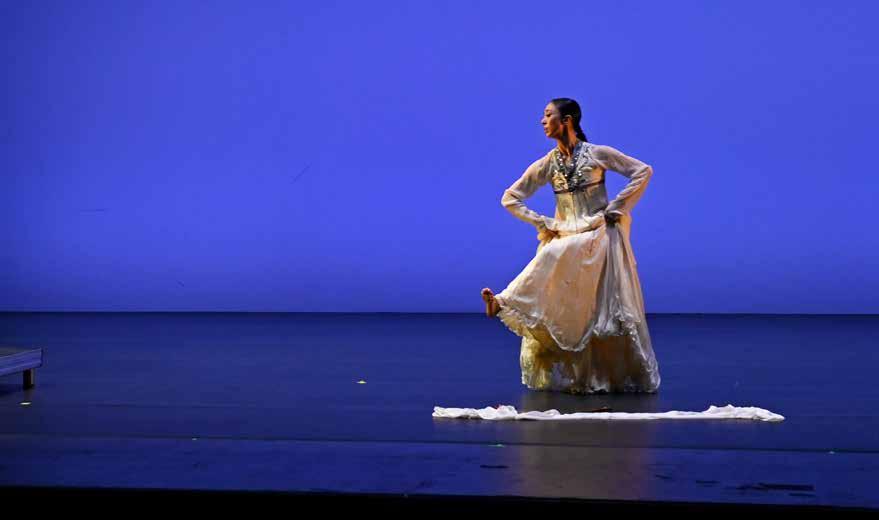
“When I first heard about this project, it was like my destiny,” said Pak. “Choi Seung Hee inspires me as a diasporic artist. She fought for women in society, for freedom of dance movement. That’s why she is great.”
Jones said that the creative process has “truly been an exercise in collaboration,” with Pak, Han and An all contributing to the work’s development. Jones and Pak gave a preliminary performance at the Danza Arte Pietra in Italy in June 2022. In January 2023, Pak and An gave the definitive premiere of “Dance for Freedom” at UNC Charlotte’s Faculty Dance Concert.

The 17-minute work, which Jones plans to expand to an eve-
ning-length program, opens with a video by Han of Korean pots in the rain. As the rain subsides, the sound of a chime in the wind fades into the meditative tone of the jing, or Korean gong, as Pak, seated at the far side of the stage, begins to play. Resplendent in a gown of white Korean silk, An emerges slowly from a long gossamer veil, like a bride. Or maybe a ghost become flesh, turning memory into movement and music.
13
Meg Whalen is director of communications for the College of Arts + Architecture.
“What Kim is doing is very urgent for this moment. She’s not arguing that she’s actually recreating this dance. It’s lost. But how do we reimagine, reperform, reenact, rethink, recover? Kim’s work is making a huge difference in terms of how we understand modern dance.”
Susan Manning Northwestern University
Kim Jones and dancer So Young An prepare for the performance of Jones’s piece, “Dance for Freedom” on the stage of the Anne R. Belk Theater in Robinson Hall.
CHEMICAL CONNECTIONS
Andrew Brotherton’s quest to save lives drives his Ph.D. pursuit
BY LYNN ROBERSON
Working weekends as an emergency medical technician while an undergraduate at UNC Charlotte, Andrew Brotherton ’22 learned that quick, accurate diagnosis of heart attacks saves lives and improves patient outcomes. He also realized that emergency responders — and patients — would benefit from diagnostic tools on ambulances and fire trucks.
“There is no worse feeling than having someone’s life in your hands and not being able to help,” Brotherton said.
Now, he is working to invent a new tool for exactly that purpose as a doctoral student in chemistry at Northwestern University. His research is funded by a National Science Foundation Graduate Research Fellowship awarded while he was at Charlotte.
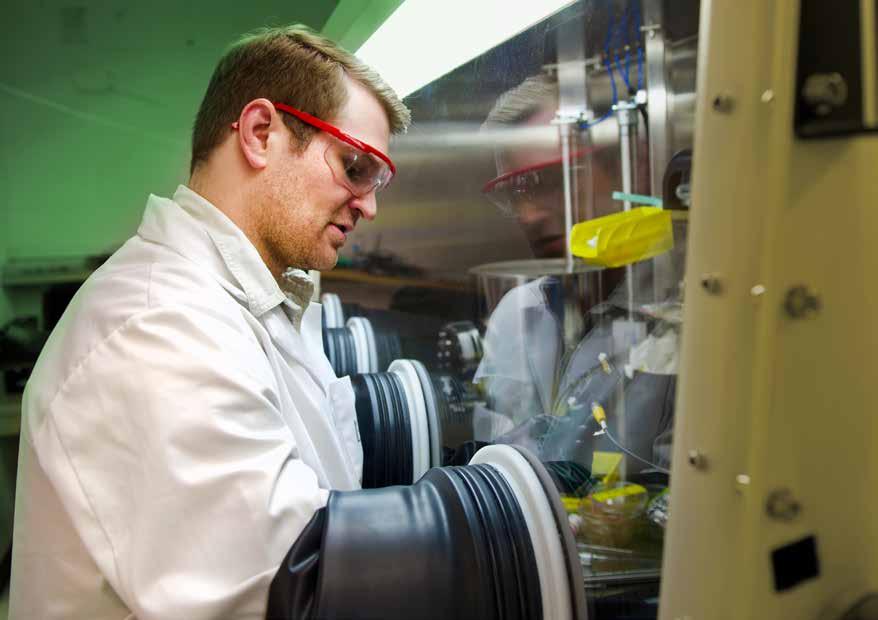
“With the biosensor I am developing,” Brotherton said, “an
EMT could prick a patient’s finger, get the patient’s blood and test their troponin levels, which is an indication of a heart attack that you can’t see with an electrocardiogram. Troponin is an enzyme that heart muscle cells excrete when someone is having a heart attack.”
If the biomarker test shows that cardiac-specific troponin has leaked into the bloodstream, emergency responders could give more detailed and immediate data to doctors, provide targeted treatment and potentially route patients directly to cardiac units or hospitals with more specialized services.
Currently, such blood tests are not routinely used in the field for many reasons including a need to send the blood samples to labs for analysis. The main tool available to medical responders for suspected heart attacks is the electrocardiogram machine,
14
which measures and records electrical signals traveling through the heart, looking for blockages or other causes.
Brotherton is investigating the use of self-assembled monolayers as biosensors. Monolayers are one-molecule-thick layers of material that bond to a surface in an ordered way through either physical or chemical forces. His aim, broadly, is to discover new properties and create new or more efficient techniques to detect disease and advance treatments to save lives.
REAL-LIFE EXPERIENCE INSPIRES RESEARCH
In addition to his adrenaline-pumping experiences as an EMT with the Lincoln County Emergency Medical Services near Charlotte, Brotherton applies knowledge acquired as an undergraduate researcher in the lab of chemist Michael Walter and from others at Charlotte. Brotherton, a Honors College student, graduated summa cum laude with a bachelor’s degree in chemistry and minors in biology and mathematics in spring 2022.
“It’s been wonderful watching Andrew grow and develop as an independent and curious researcher in the lab, through his drive and love of chemistry,” Walter said. “He’s not only driven to accomplish his own academic and research goals, but he’s passionate about teaching and helping others. In my lab, he quickly jumped in and was an author on an extremely high-impact research publication. It’s rewarding to see how his time here laid a solid foundation for him to thrive at a leading research university.”
When Brotherton first came to Charlotte in 2018, his sights were set on medical school. He had completed an EMT course and joined the EMS in Lincoln County because it was interesting and relevant to his interests. As he became familiar with the challenges he and fellow medical responders faced and dove into lab research as a sophomore, his interests shifted.
“The lab is where the real magic happens for me,” he said. “As a physician, you can see only so many patients per day. But if I am able to develop the biosensor, my work will make a wider impact. It has the potential to affect EMTs worldwide. I want the research I do to be used.”
MILITARY SERVICE IGNITES AN INTEREST IN CHEMISTRY
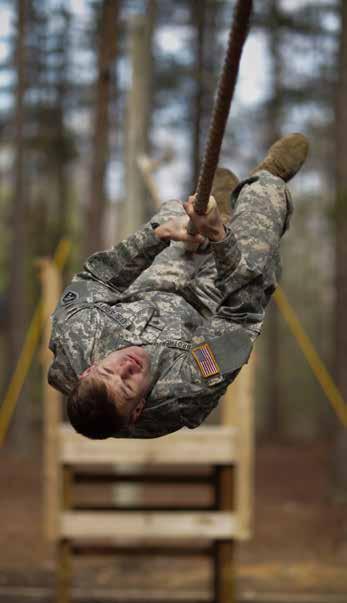

After graduating from Bandys High School in 2014, Brotherton served four years in the U.S. Army as an explosive ordnance disposal specialist and a paratrooper in support of the 82nd Airborne, followed by almost four years with the North Carolina National Guard while at Charlotte. While never deployed overseas, he had illuminating experiences, such as clearing spaces in advance of top-level elected officials.
“My first real exposure to chemistry was through courses in industrial and homemade explosives, and chemical, biological and nuclear weapons,” he said. “The EOD field was interesting and a great experience, but I found myself asking deeper questions about how the molecular world works.”
Later, as an EMT, he gained an appreciation for helping people who faced incredibly challenging and stressful experiences.
“A lot of people go through their entire lives never dealing with high-stress situations that intensify your appreciation for life,” he said. “I love my research. And, as an EMT, I’ve developed an appreciation for what I have in life and an awareness that our time on earth is not that long. You want to do something you’re proud of.”
15
Lynn Roberson is director of communications for the College of Liberal Arts & Sciences.
“My first real exposure to chemistry was through courses in industrial and homemade explosives, and chemical, biological and nuclear weapons. The EOD field was interesting and a great experience, but I found myself asking deeper questions about how the molecular world works.”
Andrew Brotherton ’22
Brand to watch
A $1,500 investment leads to a best-selling national watch line
BY JENNY MATZ
ABelk College of Business MBA can be a springboard to success. Just ask mogul Kwame Molden ’12, co-founder of Springbreak Watches, who is clocking nationwide success. A decade after Molden took a chance on entrepreneurship, SPGBK Watches are sold across the country in 200 retail stores, including Nordstrom, Macy’s, Belk and the Museum of Modern Art Design Store in New York City.
Molden, a native of Fayetteville, North Carolina, wasn’t always interested in business — in fact, the undergraduate degree he earned in 2009 from North Carolina A&T is in electronics and computer technology. Limited employment opportunities due to the Great Recession, along with a lack of personal fulfillment in a leadership role with a major car rental company, prompted Molden’s decision to continue his education. UNC Charlotte was a natural choice, given the breadth of advanced degree options along with the internship and job opportunities available in the Queen City.
As a Belk College of Business Fellow, Molden experienced a steep learning curve. “I read everything I could get my hands on: case studies, articles, interviews, you name it.” Among these was a subscription to Business Week Magazine, which he devoured cover to cover. One day, he discovered an article about making products on a small scale — and an entrepreneurial seed was planted.
PERFECT TIMING
Following his MBA completion in 2012, he observed the climbing popularity of high-end watches as fashion statements — Michael Kors’ trendy stainless-steel styles the most prominent.
Capitalizing on this sartorial trend, Molden endeavored to create unique and differentiated designs that were missing from the monochromatic metallic fad. In addition, he was determined to prioritize sustainability and affordability — lessons learned from the MBA program.
Contributing $1,500 each, Molden and his hometown childhood friend, Maurice Davis, launched “The White Party.” It was SPGBK’s first watch, made from high-quality maple wood.

Molden’s Charlotte marketing insights influenced SPGBK’s website design, and he started his own public relations campaign, pitching to websites, blogs and influencers. Steady coverage and pre-orders were proof that “The White Party” was striking a chord. A big break came when he brokered a
partnership with an overseas distributor that sold his product throughout Europe.
The Fayetteville natives and Aggie alumni then created designs to honor their hometown schools and alma mater and have added more vibrant colors and tested new materials, including metal and silicone.
CHAMPIONING EDUCATION
Ten years later, Molden cites education and work experience as foundational to a prosperous business. Because of that, he dedicates significant time and resources to educational efforts throughout North Carolina.
Molden and Davis believe a product’s status shouldn’t relate to its price, but it should reflect the company’s values — and influence how it gives back. From SPGBK Watches’ very earliest days, the pair have intentionally invested in their community.
Over the years, they’ve provided support and funds to various North Carolina schools, recently awarding six high school seniors scholarships to pursue higher education through a collaboration with the Two-Six Project, a Fayetteville organization that serves as an incubator for educational initiatives for youth in marginalized communities. This fall, they donated more than $12,000 worth of watches to Charlotte’s Renaissance West STEAM Academy and Riv-
16
erview Elementary School in Murfreesboro, North Carolina.
“We will forever champion teachers and educators across North Carolina who work tirelessly with students and their families to help prepare and shape their futures,” said Molden. “Whether you’re an active or retired educator, SPGBK honors those who touch the lives of students everywhere.”
ENCOURAGING FUTURE ENTREPRENEURS
“It’s extremely important for entrepreneurs to start small. Release products in increments or offer a limited service starting off so that you can capture real feedback on your business, before investing a huge amount of money or time,” said Molden. “Feedback and sales over a consistent period will give you the insight and inspiration you need to move forward.”

Molden advises full-time workers similarly for taking the first steps on their entrepreneurial journey. “Launch it on the side first; this approach may take longer, but I believe learning as you go will set up your business for potential longterm success.”
As CEO of a Black-owned enterprise, Molden recommends those interested in following his path to investigate industries where Black-owned businesses are not normally represented. “But invest where you have a genuine interest and passion. Lean into who you are; don’t be afraid to tell your story and learn as much as you can every day.”

17
Jenny Matz is senior director of engagement marketing.
“For SPGBK, we represent four key areas: our hometown and state, Fayetteville, North Carolina; HBCUs; the pursuit of education; and Blackowned business. By having these clearly defined, we can target these areas in a meaningful and genuine way.”
Kwame Molden ’12 MBA
Scan to read more about how Kwame Molden is taking SPGBK Watches to the national stage.
PHOTO BY RYAN HONEYMAN
THAT GIRL IS ON NINER FIRE
BY PHILLIP BROWN
Brenna Murray knows firsthand the stressors student-athletes face. A member of the Charlotte 49ers women’s soccer team, she understands the level of competition student-athletes contend with as they balance the pressure to perform on their teams as well as in the classroom.

Chucked into the game at age five by her parents, Murray fell in love with soccer’s competitiveness and being outdoors as part of a co-ed recreational league.
“Getting muddy was fun, which is probably why I gravitated toward playing goalie. It takes a certain kind of crazy to relish having soccer balls flying at your face at 35 miles per hour,” said Murray, who fielded scholarship offers from three other colleges before committing to Charlotte.
As a freshman, Murray attended a meeting of Charlotte’s Student-Athlete Advisory Committee, enticed by the promise of free pizza. She learned about its mission to promote positive relationships among student-athletes, teams, students, faculty, staff and all constituents of the University. “Giving to others is part of my DNA, so I connected with the committee’s goal to foster community service.”
At Leesville Road High School in Raleigh, her hometown, she helped found Pride Players as a support group for other student-athletes and band and dance team members, all who had “crazy” schedules. Through the organization, Murray and her fellow students completed a variety of community service projects.
NINER FIRE: A PEER APPROACH FOR STUDENT-ATHLETE MENTAL HEALTH
Since joining the SAAC executive board in January 2020, Murray served as the first director of student-athlete wellness and just concluded a second term as president. She also helped launch Niner Fire, a mental health support group for 49ers student-athletes.
18
Brenna Murray’s flame is burning brightly both on and off the field for the 49ers women's soccer team
PHOTO BY KAT LAWRENCE
Inspired by a similar program at Virginia Tech, Niner Fire is student-athlete managed. Participants are placed in “families” of six to 10 athletes from various sports and class standings. Each family includes a student-athlete leader trained to facilitate group discussions on topics related to athletics, such as stress management or dealing with injuries as well as broader mental health concerns associated with sex, drugs or alcohol. Sports psychologists and the University’s Center for Counseling and Psychological Services review lesson plans and provide feedback on content and appropriateness.
“Athletes are under tremendous pressure to perform at a higher level, so a family environment in which to talk about issues we face, such as dealing with injuries, is tremendously beneficial,” said Murray.
From 12 individuals in 2020, the program has grown significantly; last year, 50 athletes participated in Niner Fire families — and SACC added Niner Fire bonfires, outreach and awareness events held off campus for prospective participants where attendees play games and make s’mores.
A LUMINOUS LEADER, ADVOCATE
Murray exemplifies the notion of all-in-Charlotte. Through her SAAC involvement, she has participated in Tim Tebow’s Night to Shine, volunteered with campus and community cleanups and at First Harvest Food Bank and assisted with 5K relay races held on campus.
As a student leader, she interacts with her dean, the director of athletics and the chancellor as she advocates for her fellow
student-athletes. She’s also developing skills in mentoring as she seeks like-minded 49ers to join SAAC, while making “tons of lifelong friends.”

Her main takeaway, though, is developing the ability to care for others genuinely. “If you’re involved in an effort for the greater good versus just checking a box, it shows in your interactions with others. The connections you build with people are stronger, and the impact on the community is greater.”
LETTING SCHOOL SPIRIT SHINE
This past fall, Murray, a senior exercise science major, was a member of the Niner 9 (formerly the Homecoming Court), vying to be named the Golden Niner. In representing 49ers athletics, she wanted to share the message that student-athletes are involved in campus life beyond their individual teams.
“It was an opportunity to connect with students and fans, and let them know we appreciate their support,” said Murray. “As athletes, we know we are viewed as a privileged population on campus, but we are truly invested in Charlotte, and we want to advocate for other groups on campus, too.”
Murray is exploring graduate school as she considers a career advocating for college athletes.
“Connections you forge in college have lasting implications, and I think every Niner should be involved,” she said. “You don’t have to be a leader in every club, but do show up and participate. It makes for a richer experience.”
19
Phillip Brown is assistant director of strategic content for University Communications.
(Left) Brenna Murray on the field during the 2022 Charlotte 49ers Homecoming Game as a member of the Niner 9. (Above) Brenna serves as the president of the Student-Athlete Advisory Committee.
“Athletes are under tremendous pressure to perform at a higher level, so a family environment in which to talk about issues we face, such as dealing with injuries, is tremendously beneficial.”
Brenna Murray
BIFF POGGI:
BY MICHAEL J. SOLENDER
Head football coach Biff Poggi’s enthusiasm for joining the Charlotte 49ers is infectious — and already building momentum throughout the Queen City. This fall’s move to the American Athletic Conference and citywide excitement for an anticipated stadium expansion has 49ers fans watching — and eager for the 2023 season.
“Coming here and discovering what Charlotte is all about has been exciting,” said Poggi, who joined Charlotte after three seasons at the University of Michigan where he supported head coach Jim Harbaugh. “Our hit rate in recruiting has been nearly 90 percent. The reason is the amazing experience recruits have when they visit campus. They learn about the business community. They hear the academic presentation, experience the beautiful campus and fall in love with this place, just like I did.”
Athletics Director Mike Hill held firm on several “must haves” for selecting Charlotte’s third-ever head football coach.
“The very best coaches have incredible drive to make sure their student-athletes and their team have success,” Hill said. “Biff has a relentless pursuit of excellence. He cares deeply about the young men that are part of this program – and building something special here.”

Scan here to read the complete story of Poggi’s journey to the role of head football coach for the Charlotte 49ers by Charlotte-based freelance writer Michael J. Solender.

 PHOTO BY RYAN HONEYMAN
PHOTO BY RYAN HONEYMAN
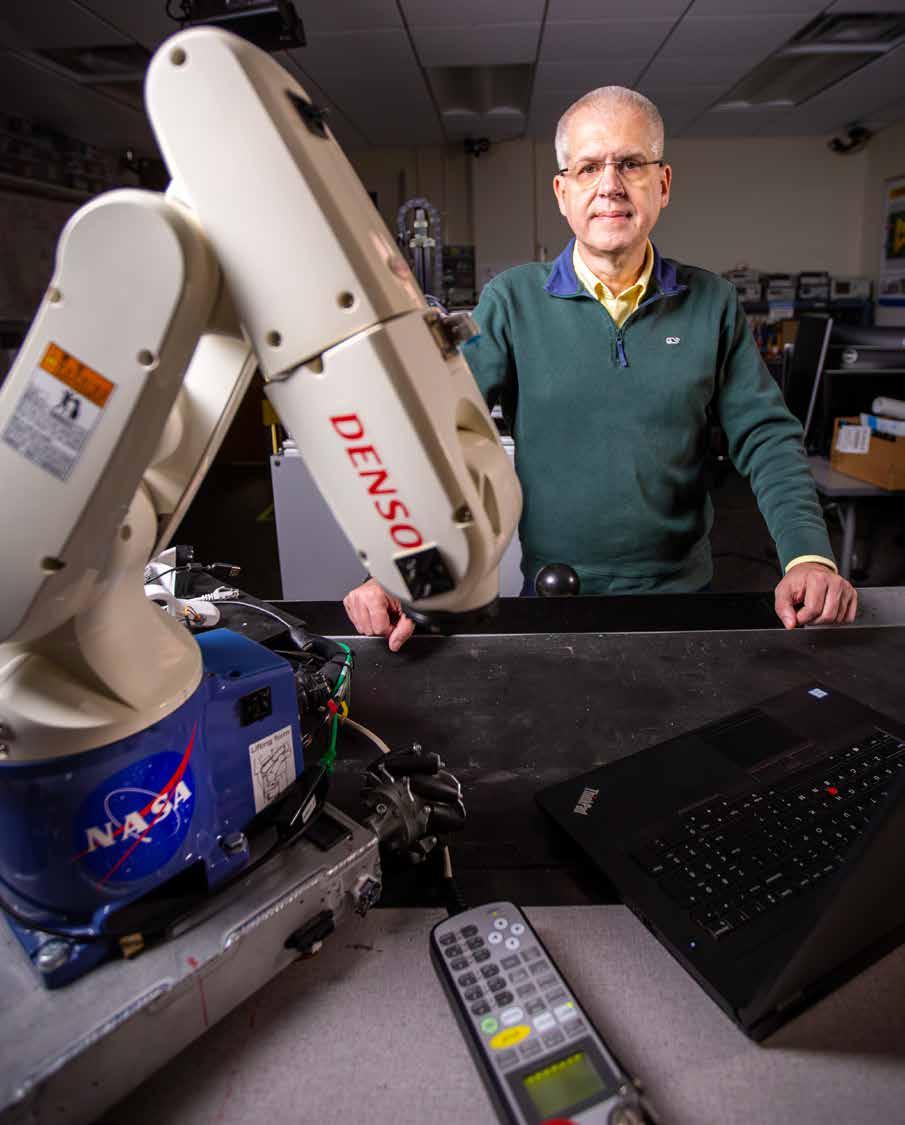 PHOTO BY RYAN HONEYMAN
PHOTO BY RYAN HONEYMAN
DOUBLE TAKE CYBERSECURITY
Aidan Browne and his team are taking the fight against cyber attacks to the floors of America’s manufacturing industries
BY SUSAN MESSINA
As a doctoral candidate at the University of Connecticut, Aidan Browne made a career decision. Academia would be his path forward — but only after gaining industry experience in a manufacturing environment.
“The best professors were the ones having first done great work in industry,” he said. “I wanted to be one of them.”
With a Ph.D. in biomedical engineering completed, Browne went to work for Hamilton Sundstrand Space Systems International. In his role as a senior electrical systems engineer, he was part of a team that developed and created two life support systems for the International Space Station: the Oxygen Generation Assembly and the Water Processor Assembly. Next came an internal shift to a division where his work as a systems engineer included using cutting-edge technology to solve challenges that could be encountered by Joint Strike Fighters, among the military’s most sophisticated aircraft.
“This is where I gained real manufacturing experience,” Browne said.
After one more industry stop at General Dynamics, which had recruited him to Charlotte to help produce biological and chemical defense products for the U.S. military, Browne made the move he’d eyed since graduate school — specifically, to UNC Charlotte. Now an associate professor of electrical engineering technology, he also directs the Master of Science in Applied Energy and Electromechanical Engineering program.
“The time was right,” he recalls.
CYBER CRIME FIGHTERS
That was in 2012. Since his arrival, Browne and his team have further sharpened their expertise through increasingly complex cybersecurity research opportunities funded by a number of federal sources (see sidebar). Now, he and his colleagues are leveraging their collective knowledge to develop solutions to the most real of threats faced today by manufacturers across industries — cyber attacks.
From IP theft and insider threats to ransomware and supply-chain attacks, U.S. manufacturers must proactively identify vulnerabilities in their computer networks that make them susceptible to external or internal cyber attacks — and be prepared to combat and mitigate them.
“The most effective way to test the security of a company’s network is to understand the potential damage a cyber attack could do,” said Browne. “The question has been how to do that without harming an entire network and operation.”
VIRTUAL BREAKTHROUGH
From the team’s cumulative research and practical experience has emerged the know-how to build a virtual copy of a company’s computer network after performing a complete audit of it. From a set of custom-built servers they call “the cyber physical range,” the team can attack the copy to determine the original network’s strengths, weaknesses and vulnerabilities, while keeping the actual network safe.
23
Our work offers an ability to directly include pieces of manufacturing systems that typically are not virtualizable. We have found a way to tap pieces of hardware that are impossible or inconvenient to virtualize.
AIDAN BROWNE
“What our work offers that other similar cyber range projects do not is an ability to directly include pieces of manufacturing systems that typically are not virtualizable,” said Browne. “What’s the point if you can’t test the entire network and detect every possible vulnerability? We have found a way to tap the pieces of hardware — physically and remotely — that are impossible or inconvenient to virtualize.”
Building on this groundbreaking capability is the development of “digital twinning” to accomplish something similar for detecting vulnerabilities in equipment on a manufacturing floor. Through a grant from Chicago-based MXD, a consortium that focuses on strengthening American manufacturing, Browne and Wes Williams, associate professor of electrical engineering technology, create the twin — a digital representation of a product, system or process used for simulation, testing, monitoring and maintenance — to be attacked and observed virtually without harming real equipment or shutting down operations.
“For example, we’re able to virtualize a robot arm so on screen you can see it moving just like the real one,” Browne explained. “So now, we can cyber attack the program in the twin as it makes

parts — and see all the ways a bad actor might alter that part ever so slightly, not visible to the human eye, but enough so that the change would affect the ability of a manufacturer to produce safe, high-quality and usable products.”
A second round of funding from MXD is pending for a partnership with Charlotte-based Siemens to produce a digital twin of the tech giant’s software on real hardware.
24
Reed Holz, a senior, early-entry student in the M.S. in Cybersecurity program, and Thomas Curry, also a master's student in cybersecurity, assist in Browne's lab.
“While some master’s degree programs are general in nature, the electromechanical focus at Charlotte shines like none other. I will continue to develop and hone my skills; lifelong learning will keep me pushing the envelope of innovation.”
Joseph Tindall ’21 ’23 M.S.
BUILDING CYBER EXPERTISE IN MANUFACTURING

UNC Charlotte faculty have developed in-depth expertise — and built a national reputation — around successful government and privately funded projects that meet critical national security needs. Among them are:
U.S. DEPARTMENT OF LABOR/MISSION CRITICAL OPERATIONS
As part of a total $35 million to a consortium of North Carolina institutions, Charlotte received a $1.5 million grant to update and optimize a system for responding to emergency technology needs at data centers that operate 24/7/365 in an environment where highly trained technology experts are scarce. The solution: Set up centers where specifically trained technicians respond to requests from partner agencies and corporations when they need support. This way each organization can access the help it needs without having to individually employ a team of experts.
NATIONAL SECURITY CENTER/SECURING AMERICAN MANUFACTURING
Based on the success of Mission Critical Operations — and the resulting infrastructure at Charlotte — the National Security Center identified Charlotte to partner with Los Alamos National Laboratory and the Y-12 National Security Complex for a project to secure the manufacturing chain for the U.S. Department of Defense and the U.S. Department of Energy. Along with federal contractor Consolidated Nuclear Security, Charlotte faculty members developed systems to deter attempts by unauthorized parties to gain access to the country’s nuclear materials or related facilities.
LOS ALAMOS NATIONAL LABORATORY/SECURING MANUFACTURING OPERATIONAL TECHNOLOGY
Now working directly with Los Alamos, Charlotte continues working toward securing the highest levels of American manufacturing with a four-year, $2 million contract that is supporting ways to vet hardware brought into federal facilities to service equipment and similar tasks.
NEXT GEN CYBER EXPERTS
Strikingly clear against a backdrop of rapidly growing need is a shortage of students to populate the next generation of manufacturing cybersecurity professionals to meet the high demand. The experience of graduate students from the William States Lee College of Engineering and the College of Computing and Informatics who have opportunities to participate in faculty-led research — and take advantage of internships with federal agencies — is regarded as highly valuable not only by the students but those in the field.
Joseph Tindall ’21 ’23, a graduate researcher in Browne’s lab, graduated in May with a master’s degree in applied engineering and electromechanical systems. Originally intending to work in robotics, he pivoted as a result of his research experience toward options that will allow him to “... combine an engineering mindset, a desire for automation and a joy of working with computers.” Now a systems engineer with FOX Sports, he is eager to delve into his career and explore further certification opportunities.
“While some master’s degree programs are general in nature, the electromechanical focus at Charlotte shines like none other,” Tindall said. “It provides a specialization that opens understanding to a multidisciplinary approach, which will prepare me for eventual leadership positions. I will continue to develop and hone my skills; lifelong learning will keep me pushing the envelope of innovation.”
Browne explains that due to the proprietary nature of protecting government computer networks, internships and jobs often require participants to be U.S. citizens, making many international graduate-level students and faculty members ineligible for contracted work.
“We can’t produce these folks quickly enough,” he said. “A primary message is ‘We need more American students to enter these fields.’ There are challenging, high-paying and rewarding careers waiting for them.”
25
Susan Messina is director of strategic content for University Communications.
Accidental Entrepreneur
A novel circuit breaker design fills an energy industry need
BY MONICA HUGHES
What began as a startup venture on the UNC Charlotte campus is making global headlines. Entrepreneur extraordinaire Ryan Kennedy ’04 heads Atom Power, an innovative enterprise revolutionizing electrical vehicle charging technology, which last year received endorsement and investment from South Korea’s largest conglomerate, SK Group. This giant backer of Samsung announced a $100 million investment in Kennedy’s groundbreaking company.
Atom Power’s supercharged success wasn’t pre-ordained. It results from several fundamental anchors Kennedy developed and refined as an undergraduate. He defines these as:
SOLUTION-ORIENTED SPIRIT
Kennedy gained an appreciation for power semiconductors and for making things from scratch. “At that time, the William States Lee College of Engineering had a relatively modest budget, so we had to find creative ways to make our class projects. For example, we had to come up with the idea and design, then fund and build senior design projects all on our own. This cultivated my ability and desire to remove barriers, a trait I maintain.”
CAREER CONFIDENCE
After graduating, Kennedy, who had worked in building design before deciding to enroll at Charlotte, remained in that field before founding Atom Power through UNC Charlotte’s university-industry hub, PORTAL. “At this point, I shifted from a very successful fulltime position to an entrepreneurial career. This drove home the reason I decided to go to college in the first place — to design products in the electrical industry.”
STRATEGIC NICHE
Atom Power was built on the intersection of Kennedy’s trade skills, technical education from the W.S. Lee College of Engineering and entrepreneurial development at PORTAL, and professional experiences in building design. “I never became an entrepreneur by aspiration. I simply recognized there was not a company doing what Atom Power is doing.”
FROM WORKFORCE TO COLLEGE TO CEO
After high school, Kennedy originally thought he was an unlikely candidate for higher education.
“I simply needed a job, so my friend’s dad got me a position as an electrician’s apprentice with a local Charlotte firm. I grew into the role, got my electrical license within three years and began running a crew on large commercial projects in uptown Charlotte,” he said.
Increasingly, Kennedy wanted to learn how electrical equipment and systems were designed, which led him to Charlotte. “I already knew about the University as both my parents are alumni, and I had heard it has a good engineering program.”
He graduated in 2004 magna cum laude with a bachelor’s degree in electrical engineering. A decade later, Kennedy founded Atom Power to make commercial power safer and more efficient through a novel circuit breaker design. Today, Kennedy describes Atom Power as an energy-delivery company, manufacturing digital circuit breakers to power electric vehicle chargers. SK Group’s investment will enable the company to expand nationally and internationally from its base of operations in Huntersville, North Carolina.

26
Chancellor Sharon L. Gaber got a firsthand look at Atom Power's Huntersville facility during a recent tour.
FOCUS ON SOMETHING THAT IS GOING TO CHANGE THE WORLD
“If you are going to spend at least four years studying in your field, use your time to have optimal impact. This mentality will produce the most output for both University research and your impact. In engineering, I would always think about how to maximize a technology — no matter how improbable it might seem. Outcomes change dramatically when you don’t settle for ‘good enough.’”
LOOK PAST THE CLASSIC
“I approach ‘finding your place’ in a much more philosophical way. For me, it takes letting go of the classic metrics of success, such as career path or salary or position. Instead, focus on the absolute greatest thing that you can accomplish with your knowledge and experiences. Know that failure is likely and do-overs are even more likely. It is not the ‘safe’ path, but it is one that can lead to the greatest possible outcomes.”
LEVERAGE YOUR NINER CONNECTIONS
“Early on, Atom Power needed technical advisors for the company. The first technical advisors were UNC Charlotte faculty. As we progressed, we were able to utilize some of the lab resources within EPIC prior to obtaining enough capital to build our own.”
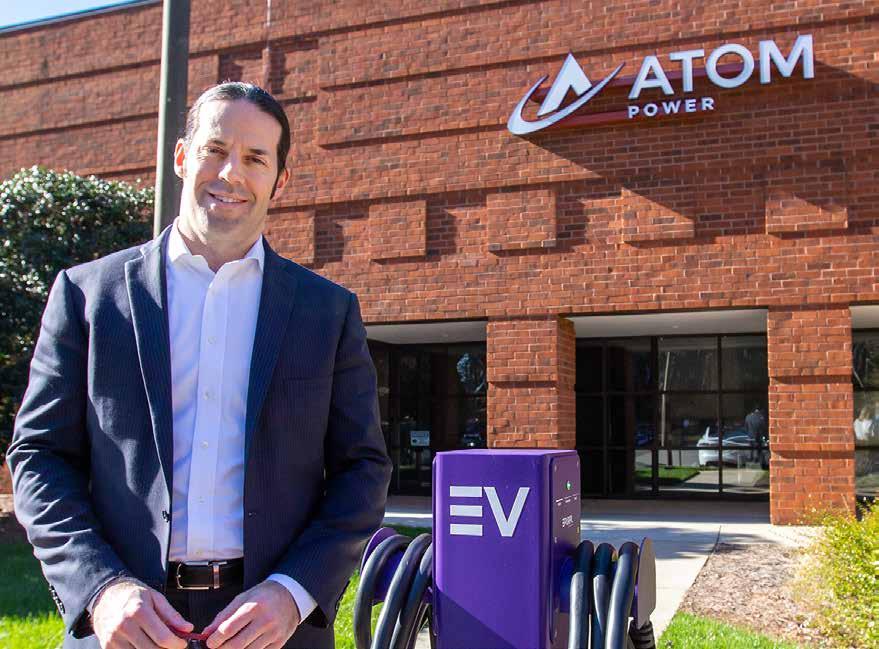
THINK BIGGER
“UNC Charlotte has so many strong people and unique resources, key for alumni impact. As a 49er, I am driven to see the University become something truly great, something representative of its capabilities. That’s a bit of a personal mission, and it’s why I consistently stay engaged. We must think bigger.”
27
Monica Hughes is director of external relations for the W.S. Lee College of Engineering.
Kennedy’s focus for the next decade is to execute Atom Power’s vision across the globe. While he didn’t aspire to become an entrepreneur, he has embraced the role, and he offers his own perspective for other pioneering 49ers:
GUIDING PRINCIPALS
Preparing school leaders to make a positive impact
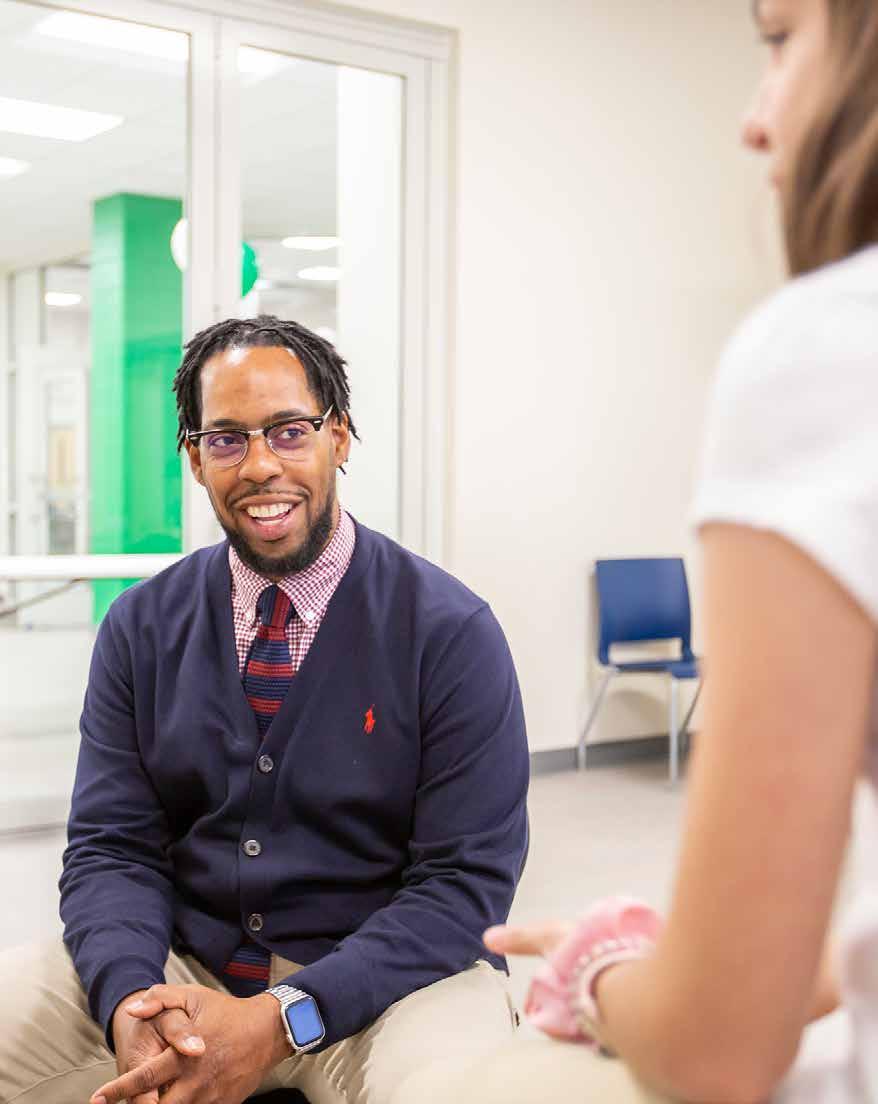 BY SONJA BARISIC
BY SONJA BARISIC
“The entire Aspiring Principals program is a lot of work. But when you are put in a position to be an administrator, you’re prepared.”
Straun Alexander assistant principal Kannapolis Middle School
PHOTOS BY RYAN HONEYMAN AND KAT LAWRENCE
Straun Alexander was in a classroom chatting with other aspiring principals when he received a tap on the shoulder. A parent needed to see him right away.
Waiting in another room was a parent, angry because her son was suspended after getting into a fight started by another student. Alexander assessed the situation, calmed the parent down and did his best to remain composed.
The surprise scenario was a problem-solving, role-playing exercise that’s a key part of the Aspiring High School Principals program. UNC Charlotte and Charlotte-Mecklenburg Schools collaborated to create the program, which recruits, trains and supports prospective principals to serve in the CMS system and beyond.
According to Alexander, a former postal clerk in the Navy who taught language arts and social studies to sixth, seventh and eighth graders before going into administration, having had that role-playing experience was helpful when he encountered a similar situation in his new job as assistant principal at Kannapolis Middle School.
“The entire Aspiring Principals program is a lot of work,” said Alexander. “But when you are put in a position to be an administrator, you’re prepared.”
“The one thing I liked more than anything was the real-life scenarios,” said Alexander, who is on target to finish the program in May 2024 and hopes to someday become a superintendent. “They come pretty close to what you experience as an administrator.”
ADDRESSING A NEED FOR QUALIFIED PRINCIPALS
Aspiring Principals began in 2013 with eight students. Since then, about 200 students have graduated from the program, which is taught at a CMS school. It has become so popular it has a waiting list of people hoping to capture one of the approximate 25 slots available each year.


Looking at retirements and regular attrition among its principals, CMS saw the need to better prepare more people to move into the principal role, especially at the high school level, said Jeveleyn Bonner-Reed, who was both the director of grant innovation and the director of human resources strategic initiatives at CMS and worked closely with the Aspiring Principals program for years. In 2022, she became executive director of the Belk Foundation, a Charlotte-based family foundation that supports public education.
Scan to learn more about the participants and how the Aspiring High School Principals program recruits, trains and supports prospective principals to serve in local school systems.

29
“I cannot imagine a program making me feel better prepared for real life every day,”
Lacee Jacobs, principal Mount Pleasant High School
Debra Morris, center, and her colleagues Rebecca Shore and Jim Watson lead the Aspiring Principals program.
“It takes a certain kind of person to lead high schools. It’s really hard to fill those positions with the best people,” Bonner-Reed said. “The schools are bigger, there’s more responsibility, you’re leading more students and staff, there’s athletics.”
UNC Charlotte was one of four universities that CMS partnered with as part of a seven-year, $7.5 million Wallace Foundation grant for CMS’s Principal Pipeline initiative, Bonner-Reed said. Aspiring Principals has continued as its own, sustainable program beyond the grant.
To help put the Aspiring Principals program together, UNC Charlotte reached out to Debra Morris, Ed.D., a retired school superintendent and former state principal of the year in North Carolina. UNC Charlotte and CMS worked with the New York Leadership Academy, which provided many ideas, such as the angry parent scenario.
RIGOROUS REAL-WORLD SCENARIOS
“A lot of people go through class and are taught from a textbook,” said Morris, Master of School Administration graduate program director and clinical associate professor. “This is actual, practical experience.”
Participants “get to practice all these skills and it tells them so much about themselves,” she said. “You see which people are open to feedback and which people take things too personally.”
The program consists of three strands, Morris said. The UNC Charlotte Department of Educational Leadership offers a 36-hour Master of School Administration program, a 21-hour School Administrator License program, and a five-week intensive summer experience for candidates who hold a School Administrator license in Mecklenburg County.
Students in all three strands participate in the summer intensive. From the beginning, summer intensive instructors have included Rebecca Shore, Jim Watson and Marion Bish. Jamie Kudlats and Walter Hart also now share their time with the program.
Aspiring Principals is successful because it is rigorous and highly tailored to CMS’s needs, Bonner-Reed said. She added that she was impressed by UNC Charlotte’s creation of a scholarship program to encourage more Latinx teachers to strive to become CMS principals.
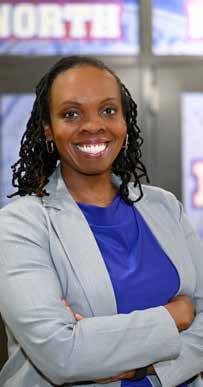
Aspiring Principals alumni and current participants say the program creates a supportive community of fellow aspiring principals, mentor principals and instructors. Many participants stay in touch with Morris — and one another — once they complete the program.
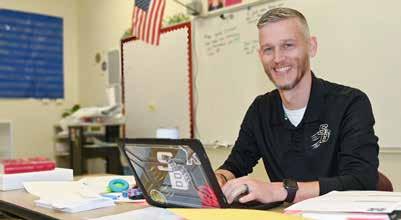

30
is a
writer
Sonja Barisic
freelance
based in Norfolk, Virginia.
“It helps me communicate with my staff, the students, the principal, the community, and create a better plan for the school.”
Aalaa Fouly, vice principal Intellicor International Academy
Aspiring Principals is “all the different pieces of the job that you don’t necessarily think about — managerial, building school improvement plans, creating data sets, being able to look at the budget to say here’s how we’re going to allocate funds.”
Dan Miller, principal Selma Burke Middle School “(The program leaders) coach you while you’re in this setting. To have that feedback on your leadership is rare.”
Stephanie Hood, principal North Mecklenburg High School
Sifting through history
STORY AND PHOTOS
BY LYNN ROBERSON
A North Carolina archaeological dig unearths new knowledge about early 20th-century Black education
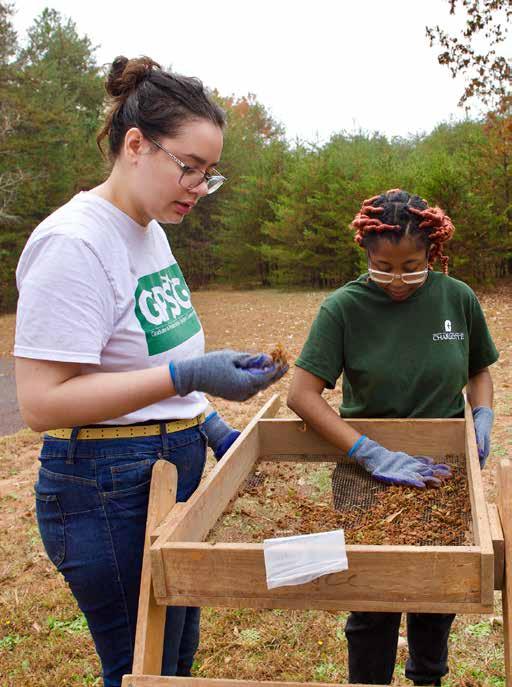
Growing up in Mississippi, Camille Richardson witnessed the telling and retelling of the tragic story of a family member who perished when the Ku Klux Klan firebombed his home.
“While saving his family from the fire, he didn’t make it out,” Richardson said. “My mother first told me the story when I was very young. That’s one thing that has always remained with me.”
While the heartbreaking tale is a significant piece of family lore, Richardson noticed that such histories went largely untold in predominantly white schools.
“We didn’t hear about the horrible things that had happened to people,” Richardson said. “My mom told me, ‘We’re not listened to. We tell our stories, but they are not heard.’”
PRESERVING LINCOLN COUNTY’S ROSENWALD SCHOOL
Now, as a UNC Charlotte master’s student in anthropology, Richardson is listening, while centering a master’s thesis in archaeological and historical research with the Mount Vernon Rosenwald School near Charlotte. Rosenwald Schools were built almost a century ago to educate African American children in rural communities and are regarded as the most important effort to advance Black education in the early 20th century. While 5,000 were built, the National Trust for Historic Preservation estimates only about 500 survive today.
The Lincoln County school opened its doors in 1925 on the site of a previous school for African American children. A non-
31
“With this work, we’re able to help make space for people to tell their stories and correct the incorrect stories we hear.”
Camille Richardson
Anthropology master’s degree students Taylor Recuero and India McCoy look for artifacts at the Mount Vernon Rosenwald School archaeological dig.
profit organization formed in 2015 to restore the school as a community center. Wanting help in documenting more of the school’s past, the nonprofit’s leaders connected with UNC Charlotte bioarchaeologist Sara Juengst.


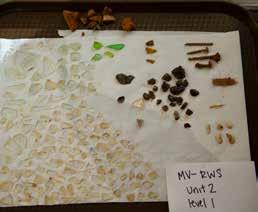
Juengst, Richardson and other Charlotte students, alumni and faculty have literally dug into history on the site. They have painstakingly scraped, inch-by-inch, through layers of red clay dirt in strategic spots around the school and brought the artifacts to a Charlotte anthropology lab to clean, catalog and research.
“In the archaeological record, children aren’t really written about too often,” Richardson said. We don’t hear about their
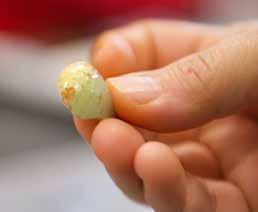
experiences and the impact social or other factors have on them, particularly African American children. Work like this can give us a view into items they were using and what their lives looked like when they were at the school.”
FOR THE RECORD: FORMER SCHOOL ATTENDEES TELL THEIR STORIES
Richardson has interviewed school alumni, recording their remembrances for research purposes and to share with the restoration champions as oral histories. At first glance, the artifacts could appear insignificant. A longer look, coupled with observations by the school’s alumni, reveal their substance.
32
UNC Charlotte anthropology student Camille Richardson and bioarchaeologist Sara Juengst examine artifacts unearthed at the Mount Vernon Rosenwald School.
Even pieces of broken soda bottles, with faded lettering from brand names, conjured memories for school alumni. They told the Charlotte student researchers that the soda bottles could not have been theirs because they were too poor to bring soda for lunch. Some soda brands were considered by some to be off limits to African Americans, meaning storekeepers sold them only to white people, they recalled.

The team found crushed metal ends of pencils with desiccated erasers. A broken marble and a smashed car made of clay hinted at children’s imaginative games. Nails, shards of window glass and clay bricks likely made on site revealed construction practices.
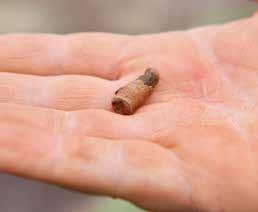
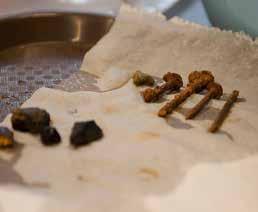
“It’s because these items are not what might be considered important artifacts that they have significance,” Juengst said. “These are the types of items nobody thinks about. That’s the reality of everyday life. To some extent, it’s the mundane nature of our finds that make them more interesting and significant.”
While digging, Rosenwald alumnus David Patterson described games children played, lessons they learned and chores they completed, such as keeping the stove stoked on cold winter days to heat the two-room school. Patterson and other alumni guided the team on where to dig, remembering where they most often played and the location of the pit where they buried their trash.
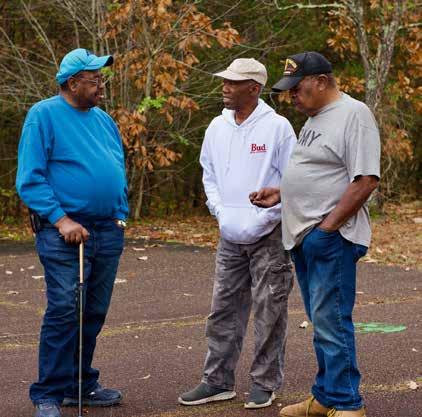
The work underway is intended to illuminate the school’s history and contribute to efforts to bring some sort of historical designation for the school, which is owned by Mount Vernon Missionary Baptist Church.
“We would like to renovate this building completely and restore it to its original condition,” said Ola Mae Foster, a leader in the effort. “We think it’s going to be a rebirth for the community.”
Joe Patterson, another Rosenwald alumnus, would welcome the revival. “From the time I was growing up here, the community has lost over 40 families,” he said. “They left for different reasons. This is part of the past that we could make connections to.”
REBUILDING COMMUNITIES
Richardson’s interest in the Rosenwald School effort was natural as it links with a focus on disparities in education and housing. Richardson works as the program and development fellow with Rebuilding Together of Greater Charlotte, a nonprofit focused on neighborhood-based home repairs.
“Camille’s upbeat attitude, person-first approach and genuine care for the homeowners we serve has been evident since they stepped foot into our office,” said Kim Savage ’20, ’21 MPA, development and communications manager for Rebuilding Together. “Camille has made it much easier for our clients to
access our services and has comforted many of them through the home repair process.”
For Juengst, the Mount Vernon partnership offers a way for students to gain archaeological experience. Her research usually is conducted in South America, and she strives to have opportunities for students to join her on those trips to gain research experience.
“Tons of students cannot travel to South America for six weeks or for three months over the summer,” she said. “They may not have the money or even the desire. I believe you shouldn’t have to go abroad to do archaeology, so I’ve had my eyes open for a local project. This project is appealing because it has future opportunities for students who are interested in community building, grant writing or other aspects of this work.”
33
Lynn Roberson is director of communications for the College of Liberal Arts & Sciences.
Former Rosenwald students: Joe Patterson, Garnell Jackson and David Patterson
Weighing Risk, Seizing Opportunity
BY LINDSAY LENNON
Khem Khadka ’22 has proven that despite enduring harsh living conditions for years, it is possible to accomplish great things. The key, he says, is persistence and applying lessons from each chapter of life toward a positive outcome.
By December 2023, his persistence will pay off with a master’s degree in data science and business analytics — his second degree from UNC Charlotte — and put him on a path to fulfill his dream of completing advanced studies to improve his and his family’s socioeconomic condition.
In his native country of Bhutan in southern Asia, political turbulence led to his family’s exile when he was only 8 years old. For the next 18 years, they lived — and Khadka attended school — in an area designated for refugees. Finally, at age 26, he was able to immigrate to the United States with his wife, Khima.
PART-TIME JOB, FULL-TIME DREAM
Upon arriving in Raleigh, North Carolina, in 2009 — in the midst of the Great Recession — he grabbed opportunities when they came his way, starting with a position in the produce department at Fresh Market. Rather than becoming discouraged over being hired only part-time due to limited options in the overall economy, Khadka persisted until he became a full-time staff member.
Working alongside high school students, many who believed higher education is a “scam” that would leave them with heavy debt and lacking a secure career, Khadka found ways to encourage them to assume a more positive outlook while reminding them how fortunate they are in America. “I told them, you need to have a mindset around building your own opportunities. There are plenty if you look for them — and do not expect them to be handed to you.”
As the couple settled into their new life, Khadka explored education opportunities. He began by earning 12 credits at Wake Technical Community College while working full-time at Fresh Market. As this schedule became difficult to manage, earning a degree became a top priority. With savings, Khadka and his wife moved to Charlotte in
2016 after hearing from friends about the Queen City’s extensive opportunities. He landed a job at a Black and Decker warehouse, where a more consistent work schedule allowed him to focus on his studies.
DATA SCIENCE FOR THE WIN
Meanwhile, he enrolled in the undergraduate data science program at UNC Charlotte and received the Carol A. Douglas Re-entry Scholarship, designed specifically for nontraditional students. Drawn to data science because of the field’s recent rapid growth, he recognizes the competitive advantage of data science expertise in the job market.
“With a rise in the availability and computing power of computers, many companies are turning toward previously unharnessed possibilities hidden in their data,” Khadka said. “I chose Charlotte because it’s the only university in the Carolinas that offers a B.S. in data science. The program applies mathematics and the power of computing to real-world problems while using data to help solve them.”
In May 2022, Khadka was among the first 11 graduates of the Bachelor of Science in Data Science program offered by UNC Charlotte’s School of Data Science. Today, he is enrolled in the Master of Data Science and Business Analytics program and was able to gain valuable experience through a paid internship with Wells Fargo’s Model Risk group. In addition to contributing to the development of models that forecast risks, he was involved in business analytics, coding, machine learning and Python.
This summer, Khadka’s momentum continues when he starts a full-time position with Honeywell International as a system analyst, allowing Khima and him and their children, Ryan and Ruby, to remain in Charlotte. Reflecting on his journey, Khadka observes how “... some people in America believe there isn’t a lot of opportunity here — but they can’t compare it to life elsewhere; it’s about perspective.”
34
Lindsay Lennon is the communications and events manager for the School of Data Science.
Adversity did not deter data scientist Khem Khadka ’22 from persisting toward his goals — or making the most of every available opportunity.
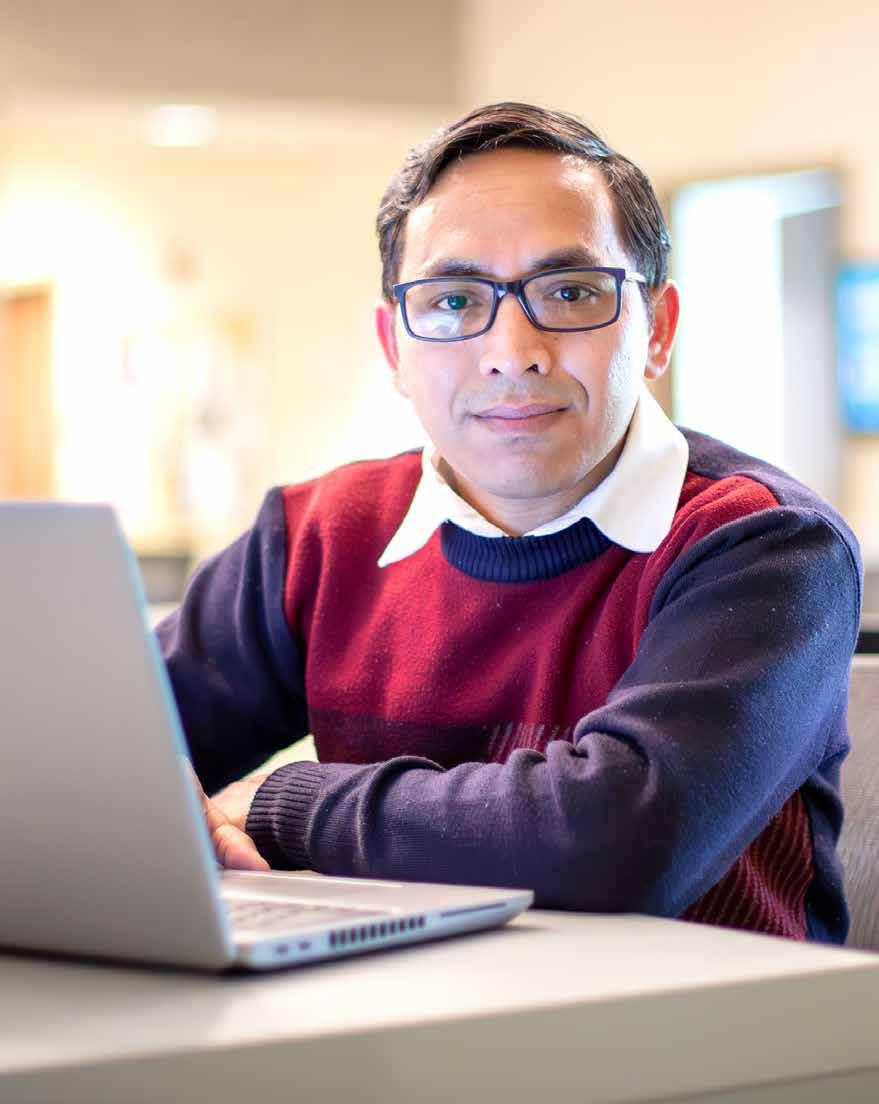

“You need to have a mindset around building your own opportunities. There are plenty if you look for them — and do not expect them to be handed to you.”
Khem Khadka ’22
PHOTO BY RYAN HONEYMAN
Khem Khadka '22 with his wife Khima and children Ryan and Ruby after he completed a Bachelor of Science in Data Science.
BY CHRISTY JACKSON
THE RIGHT SPIRIT FOR BUSINESS AND HISTORY
Terri White has a lot to celebrate. A self-professed museum junkie, she says she has achieved dream job status: CEO and president of the Charlotte Museum of History, a position she assumed in 2022. She was well-experienced, having previously served in leadership roles at the Heinz History Center, the Carnegie Science Center and the Smithsonian Institution National Air and Space Museum. White moved to Charlotte in 2019, right after finishing an MBA at the University of Pittsburgh, for a technology job. But when the opportunity to re-enter the museum world appeared, she couldn’t say no.
She’s also a busy student, working on a Doctorate in Business Administration in the Belk College of Business. Her area of research focus is on the economic impact of diversity, equity and inclusion in the American distilled spirits industry. Her interest comes from her family’s history in bootlegging and her research to launch her own venture, Sugar Top Spirit & Beverage Co., a distillery for a citrus-forward, American-style gin. Here, White shares how she is focused on shaping her future and the city’s by connecting with the past. Cheers to that!
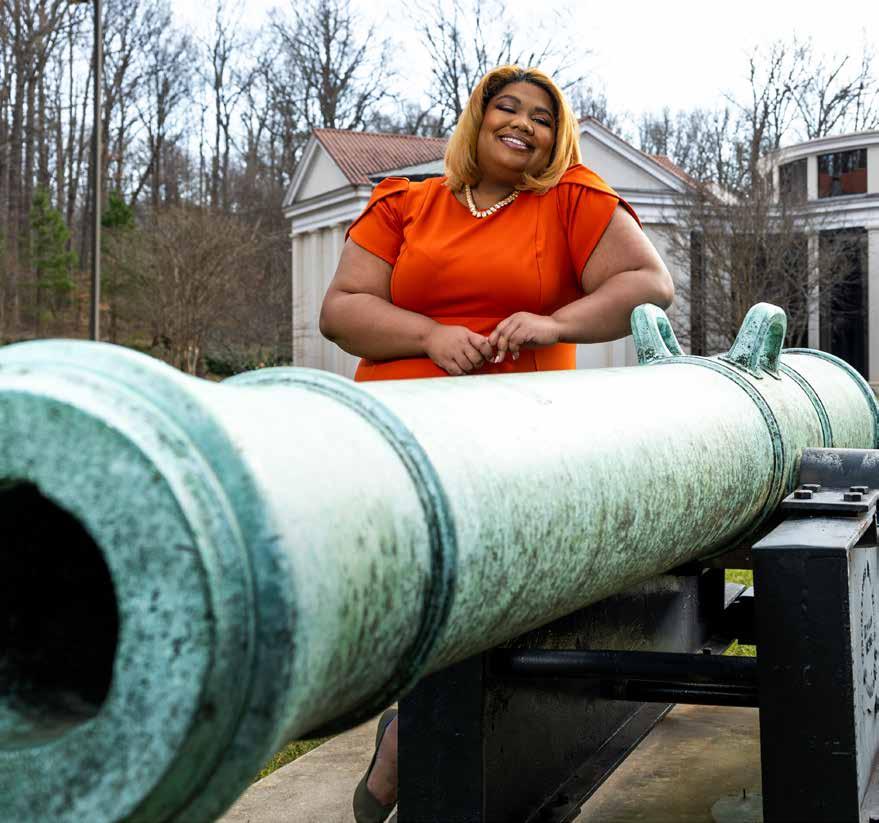
36
PHOTO COURTESY OF CHARLOTTE MUSEUM OF HISTORY
How did you build a career in museum administration that ultimately brought you to your “dream job”?
I’ve always had a library card, and I was the kid excited about the field trip to museums and historic sites. Yet, it never seemed like a real career path as a child, because I didn’t really see a lot of people who looked like me doing the work. I was in my mid-20s before it dawned on me that I could make a living in the spaces that I cared so much about. Once I was in the museum world, I saw that the people who made the big strategic decisions were the leaders. I remember I had a presentation in the Office of the Secretary at the Smithsonian. I felt very comfortable in the power
and energy there and knew that from that moment on that I wanted to influence how people learned and experienced museums. I wanted other kids to see themselves leading there.
What led you to decide to pursue a doctorate? It’s certainly no easy task on top of a busy professional life.
Trust me, it was not in my initial plan to get another degree. I was working on my spirits business while stuck in the house because of the pandemic. While researching the history of the alcohol industry and networking, I realized there were huge historical inequities in the field. It became a nerdy hobby of mine to read about this phenomenon. As I shared what I was finding, I heard people say, “That sounds like a dissertation topic!” I dismissed those comments until I ended up on a phone call with (Belk College of Business) Professor Reginald Silver. The rest is history.
So many Charlotteans aren’t from the Queen City originally. Why should they learn more about the history of the region they now call home?
As a fellow non-native, I strongly believe that people who move here need to understand the history of the people and communities they’re joining. We sometimes tend to build solutions for the problems we face today based only on what we see now. For example, we don’t always know the names of people who worked hard for the small victories that have shaped policies or the grassroot organizations that made change possible. But we need to. If we take time to understand the past, we can better influence the future.
What is the best advice you have ever received?
Stop waiting for perfection. There will always be a hurdle, a negative comment, a loophole. Always. If you wait until conditions are 100% perfect for your next step, your next step will never happen. So, move forward — be prepared to be agile and adaptable to get where you want to go.
If you could write your story exactly as you want, what would it say you are doing in five years?
I would be wrapping up a major capital campaign at the Charlotte Museum of History for critical infrastructure upgrades that will allow us to compete fully as a nationally classed museum and historic research center. My spirits business would be on its third product launch, and I’d be courting investors for category and market expansion. I also would be confirming lecture dates and finishing up the final edits on my book about African Americans in the American distilled spirits industry that chronicles our historical contributions and the economic impact we have had on the industry and related policies.
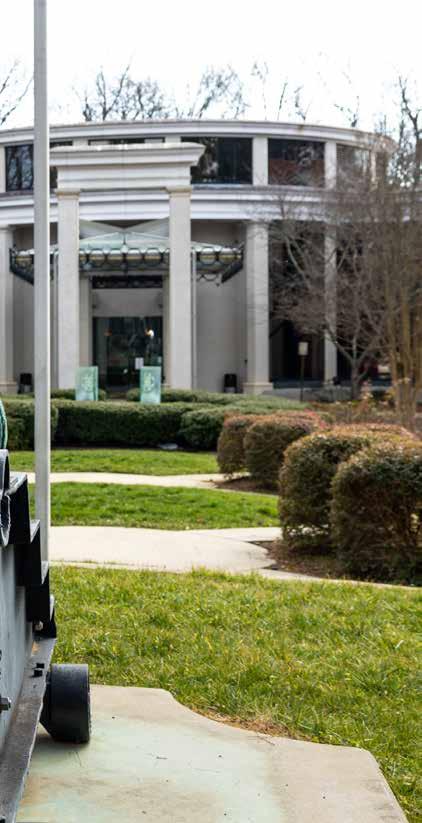
37
Terri White, CEO of the Charlotte Museum of History, is a student in the Doctor of Business Administration Program, the first of its kind in the Carolinas.
Christy Jackson is executive director of strategic communications for University Communications.
BUILDING IMPACT
Architecture projects teach students hands-on skills while solving real-world problems
Architecture associate professor Marc Manack had just completed his first academic year at UNC Charlotte. Throughout 2016-17, he wasted no time thrusting students into real-world settings to design and build structures that bring them into contact with tools, materials, physical space and the expectations of external clients.
The momentum continued through the summer as he and a group of graduate students took two trips to Chicago for hands-on opportunities designed to help spur community dialogue about housing insecurity.
“We designed a temporary installation to raise issues around public housing, development and gentrification,” Manack said.

Over two weeks, the student team constructed their installation on four different sites in Chicago. They returned that fall to make a public presentation on their work during the Chicago Architec-
BY MEG WHALEN
ture Biennial and to install their structure in Chicago’s National Public Housing Museum for an exhibition that explored housing as a human right.
In the ensuing six years, through seminars like “Good Fast Cheap” and summer graduate studios, his students have provided improvements to an old brick commercial building in Salisbury, built a covered pavilion on Charlotte’s west side, installed a play structure for a neighborhood park in northwest Charlotte, and constructed a “beacon” for the new Trailhead Arts District in east Charlotte.
“I’m an architect first, and as an architect, I want to build and make an impact on communities,” he said. “There’s no better challenge than trying to realize something you designed. Just the act of trying to make something is a lesson in and of itself. It takes a different level of commitment.”
38
Architecture associate professor Marc Manack at the 'People's Porch' in West Charlotte.
PHOTO BY RYAN HONEYMAN
TACKLING AFFORDABLE HOUSING
This spring, students have been engaged in perhaps their most complicated design/build project yet: a prototype accessory dwelling unit, or ADU, that they hope will simultaneously provide an affordable place for someone to live and an income stream for a low-income property owner. The project is a response to a request from Warren Wooten, assistant director for affordable housing at the city of Charlotte, who approached Manack with a challenge for his students.
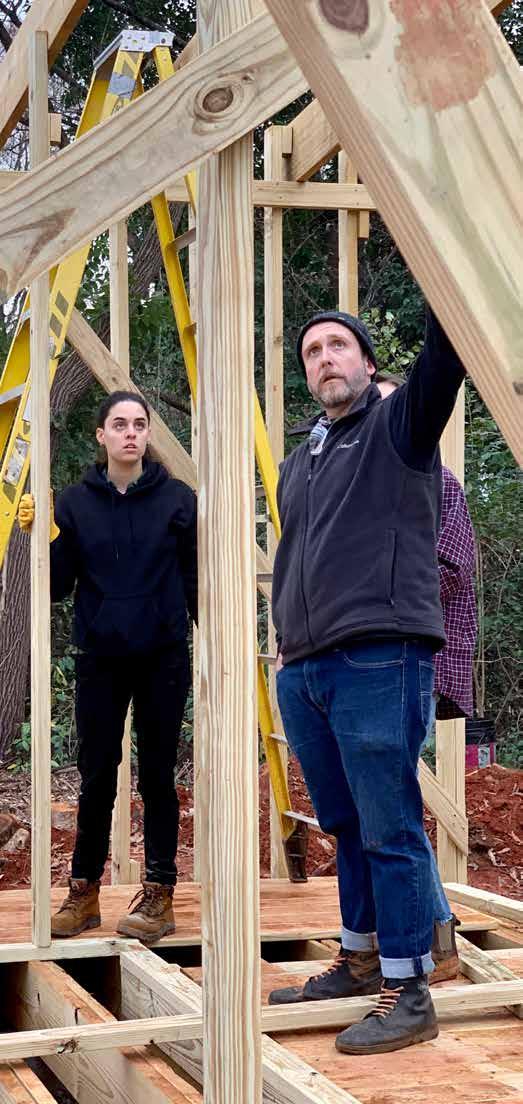
“Building connections between the University and local government is really good for cross-pollinating ideas and getting the best out of both institutions,” said Wooten, who is enrolled in the Ph.D. program in public policy at UNC Charlotte.
Wooten and Manack developed an assignment for Manack’s 2022 summer graduate studios in which students would design ADUs specifically for two Charlotte neighborhoods: Hidden Valley and Washington Heights.
ADUs are “one of the tools in the kit to address the affordable housing crisis,” said Manack. “Low-income homeowners are sitting on a lot of value, but they face displacement. ADUs can provide rental income to help mitigate expenses associated with being a longterm resident in a gentrifying neighborhood.”
The students divided into teams and over the course of two summer sessions, came up with three different small house designs based on the chosen neighborhoods.
“This was my first dive into designing with other students,” said Constanza Gonzalez Villarroel. “That was really a learning experience for all three of us. We had to work to each person’s strengths.”
39
“I see Charlotte, the city itself, as a design project. These things we build are contributing to its development and are a lasting presence for the school in the community.”
Marc Manack associate professor of architecture
Marc Manack and Keely Haggar '21.
At the end of the summer, the students presented their designs to Wooten and his colleagues.
“I was really impressed with how seriously they took the project, how well they worked in teams and how receptive they were to feedback,” he said. “We were all really pleased with the designs. I thought their ideas were innovative and clever.”
Wooten said that the city is creating an “ADU playbook” that will include the students’ plans, which he hopes will give neighborhood residents “an option to use those plans in the future.” In the meantime, Manack and a new class of students are building a modified version of an ADU design as an actual prototype. Gonzalez, one of several summer students who also enrolled in this seminar, is excited to see the design concept come to life.
“A lot of students struggle with actually visualizing what our designs look like in the actual world — what eight feet feels like,” she said.
BUILDING PROBLEM-SOLVING SKILLS
Manack said that the “build” part of design/build projects is crucial to an architectural education.



“More than swinging a hammer, it teaches them how to prob-
lem solve in real time. It teaches them respect for the trades, for the contractors. It teaches them collaboration.”
Amelia Gates ’21, who is now in graduate school at Yale University, helped design and build “The People’s Porch” pavilion in west Charlotte.

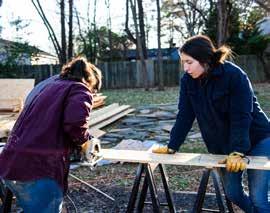
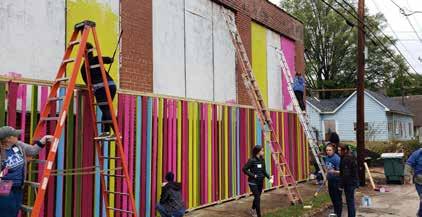
“Marc’s an amazing professor. He does not sugarcoat things at all. He gives the hard truth, which is important. He’s open and honest about the process. And he’s very encouraging.”
Gates said that throughout the pavilion’s construction and at the ribbon cutting, there was a true connection with neighborhood residents.
“Marc really wanted to know the community and have us know the community as well.”
For Manack, the public interest work that he and the students do is part of the larger responsibility that the University has to the civic landscape.
“I see Charlotte, the city itself, as a design project. These things we build are contributing to its development and are a lasting presence for the school in the community.”
40
Meg Whalen is director of communications for the College of Arts + Architecture.
Sophia Bullock ’20, and Amelia Gates '21 work on the “People's Porch” in West Charlotte.
UNC Charlotte students work on “Mending Fences,” a design/build project for the city of Salisbury that was funded by the city’s BlockWork grant program.
UNC Charlotte students created three different small house designs based on the chosen neighborhoods, Hidden Valley and Washington Heights.

Under the night sky, “Constellation Garden” is a beacon of remembrance, honoring the students who lost their lives and those who suffered physical injuries and all present in the Kennedy Building, Room 236, on April 30, 2019.

Nonprofit Org. U.S. Postage PAID Charlotte, NC Permit No 949
9201 University Blvd. Charlotte, NC 28223-0001
PHOTO BY RYAN HONEYMAN


 PHOTO BY KAT LAWRENCE
PHOTO BY KAT LAWRENCE









 BY LAURA SMAILES
BY LAURA SMAILES

 PHOTO BY RYAN HONEYMAN
PHOTO BY RYAN HONEYMAN


 PHOTO BY RYAN HONEYMAN
PHOTO BY RYAN HONEYMAN
















 PHOTO BY RYAN HONEYMAN
PHOTO BY RYAN HONEYMAN
 PHOTO BY RYAN HONEYMAN
PHOTO BY RYAN HONEYMAN




 BY SONJA BARISIC
BY SONJA BARISIC




























